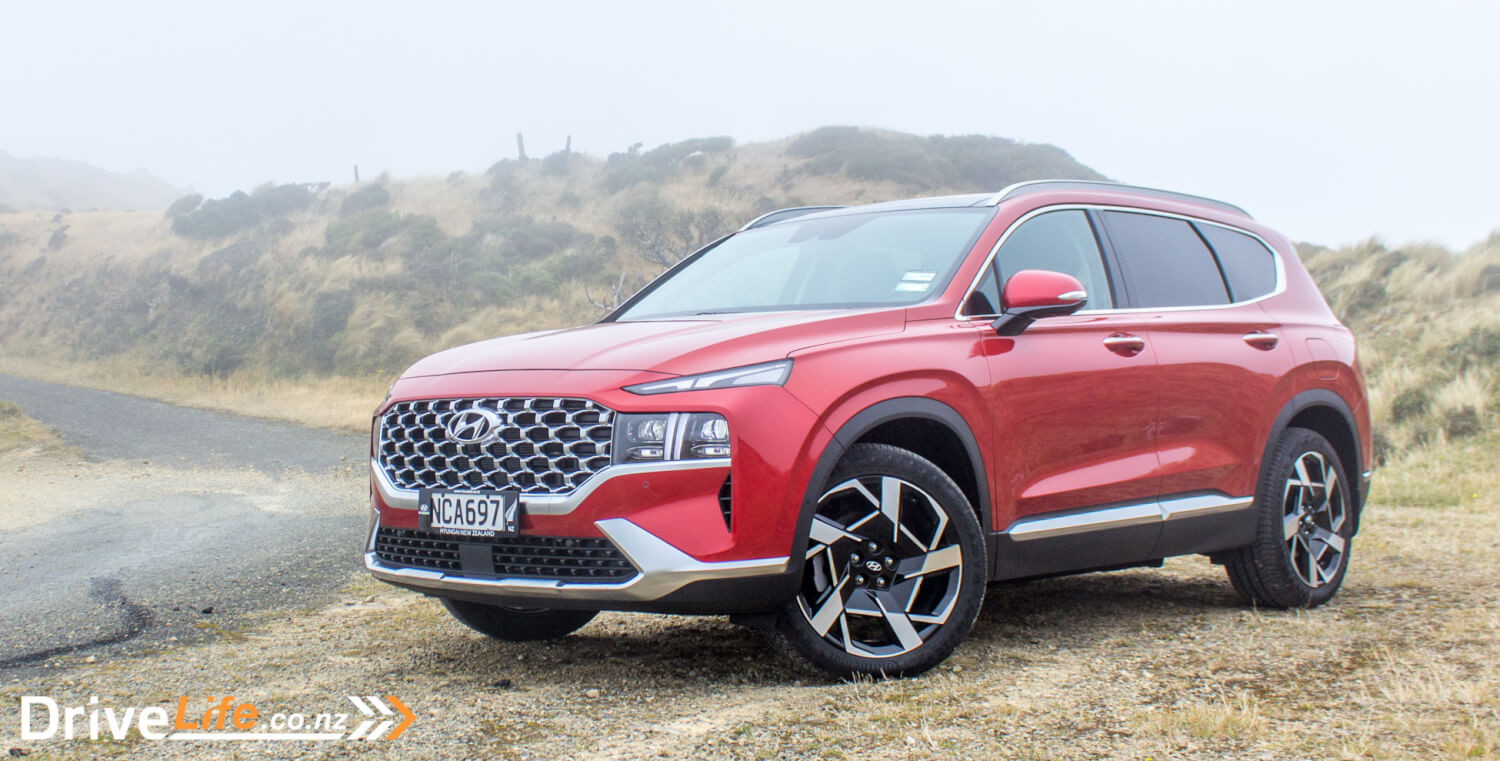The Santa Fe is undoubtedly an icon car for Hyundai. It has a hugely loyal following, and has driving dynamics that are a match for other Japanese or Korean brands, and dare we say it – some euros as well.
It’s a good-looking SUV too, so it’s hitting all the markers to sell in reasonable numbers. We last reviewed this car in 2019 with me behind the wheel, and I very much enjoyed the car. The chassis was superb and the overall refinement was a highlight.
For 2021 and its fourth generation, Hyundai have freshened the look a little, and improved drivetrains that deliver what Hyundai says is the most powerful Santa Fe yet. Hybrid and plug-in hybrid models will arrive sometime this year. There’s also an increase in the diesel model’s tow rating (2,500Kg) as the car now sits on Hyundai’s latest SUV platform.
It is also easier than ever to park the new Santa Fe as it comes available with a Surround View Monitor (SVM), Reverse Parking Collision-Avoidance Assist (PCA) and Remote Smart Parking Assist (RSPA) for selected models.
We got sent a top-spec diesel Limited model for a week to see what we thought of it. Will it continue to do well for Hyundai, when this top-spec model retails at almost $90,000?
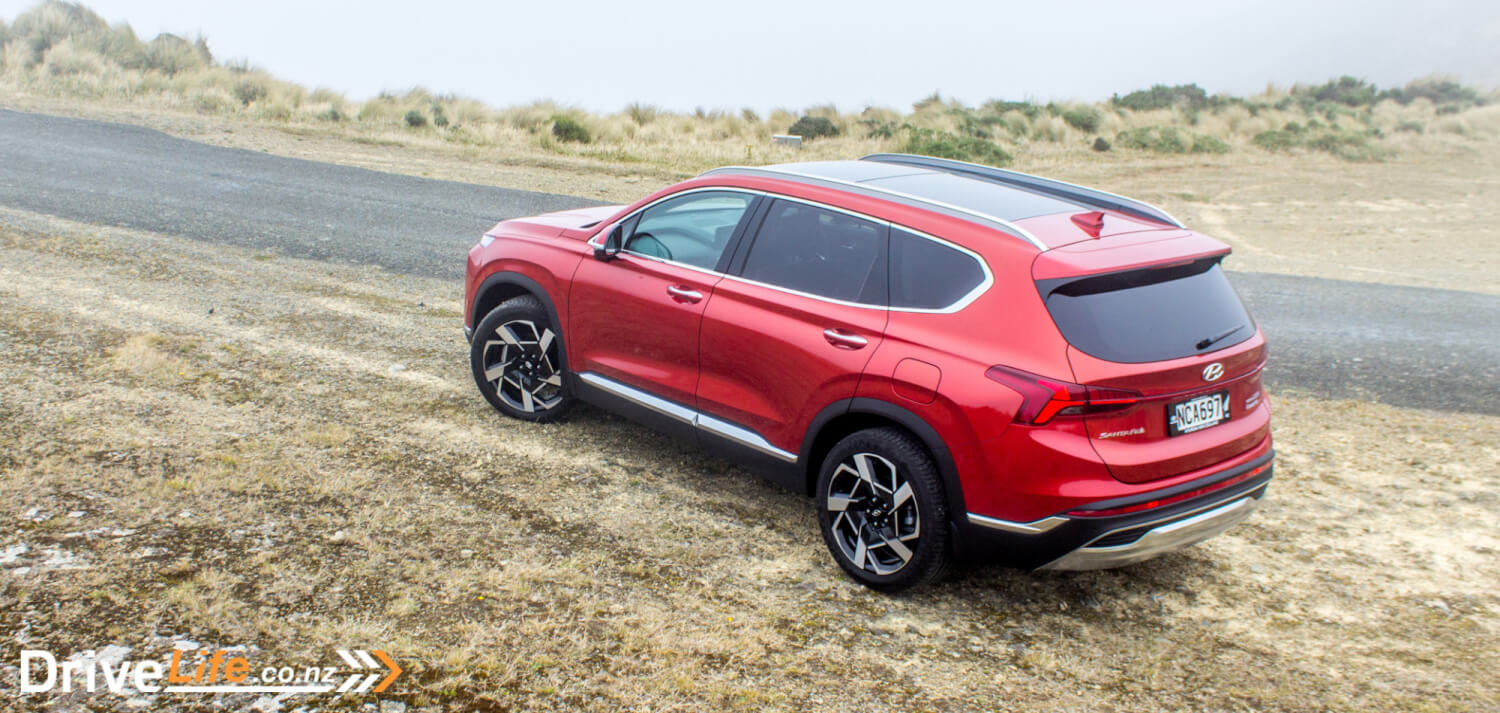
What’s In The 2021 Hyundai Santa Fe Range?
There’s three models in the Santa Fe range, two of them have diesel and petrol options. This means you can get the Entry, Elite and Limited models with either a 2.5-litre, 4-cylinder engine or with a 2.2-litre, 4-cylinder turbo-diesel. You can still buy a 3.5-litre, V6-powered Santa Fe but only in Limited trim. The V6 Santa Fe is front-wheel drive only, while the other models are all-wheel drive as standard.
Starting at $62,990 for the base petrol Entry model, features are still reasonable with dual-zone AC, keyless entry and start, an 8” central touchscreen display, front and rear parking sensors, LED headlights (low-beam only), a reversing camera, 18” alloy wheels, hill start assist, blind spot monitoring, driver attention warning, Forward Collision Avoidance Assist, automatic high beams, lane keep assist, lane following assist, rear cross traffic alert, adaptive cruise control with Stop and Go function, dual-zone AC, keyless entry and start, an electric park brake, an 8” central touchscreen with Apple CarPlay and Android Auto, LED DRLs, and heated and electric folding mirrors.
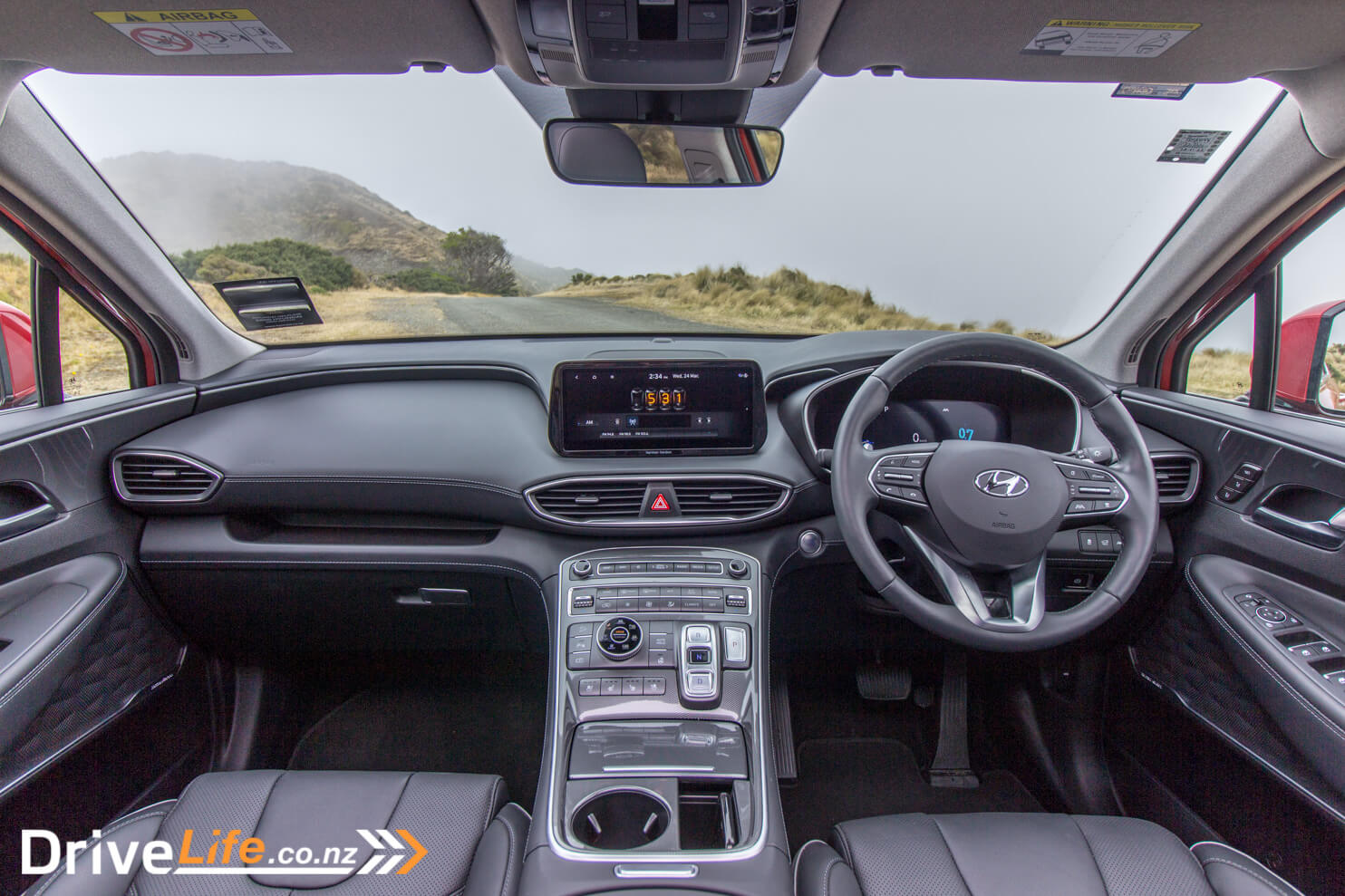
Moving up to the Elite, you will then get added a heated leather interior (including second row), push-button gear selector, a 10.24” central touchscreen display, Harmon Kardon sound system, electric front seats, 20” alloys, Bi-LED headlights and taillights, paddle shifters, wireless phone charging, a heated steering wheel, deluxe interior trim, auto wipers, and privacy glass.
Naturally the Limited model goes all out with a panoramic sunroof, an electric tailgate, Surround View Monitor (360-degree camera system), Remote Smart Park Assist, Reverse Parking Collision Avoidance, a heads-up display (HUD), blind-spot view monitor, 14-way electric driver’s seat with memory, ventilated front seats, LED interior mood lighting, Continental tyres, and a 10.25” TFT driver’s display.
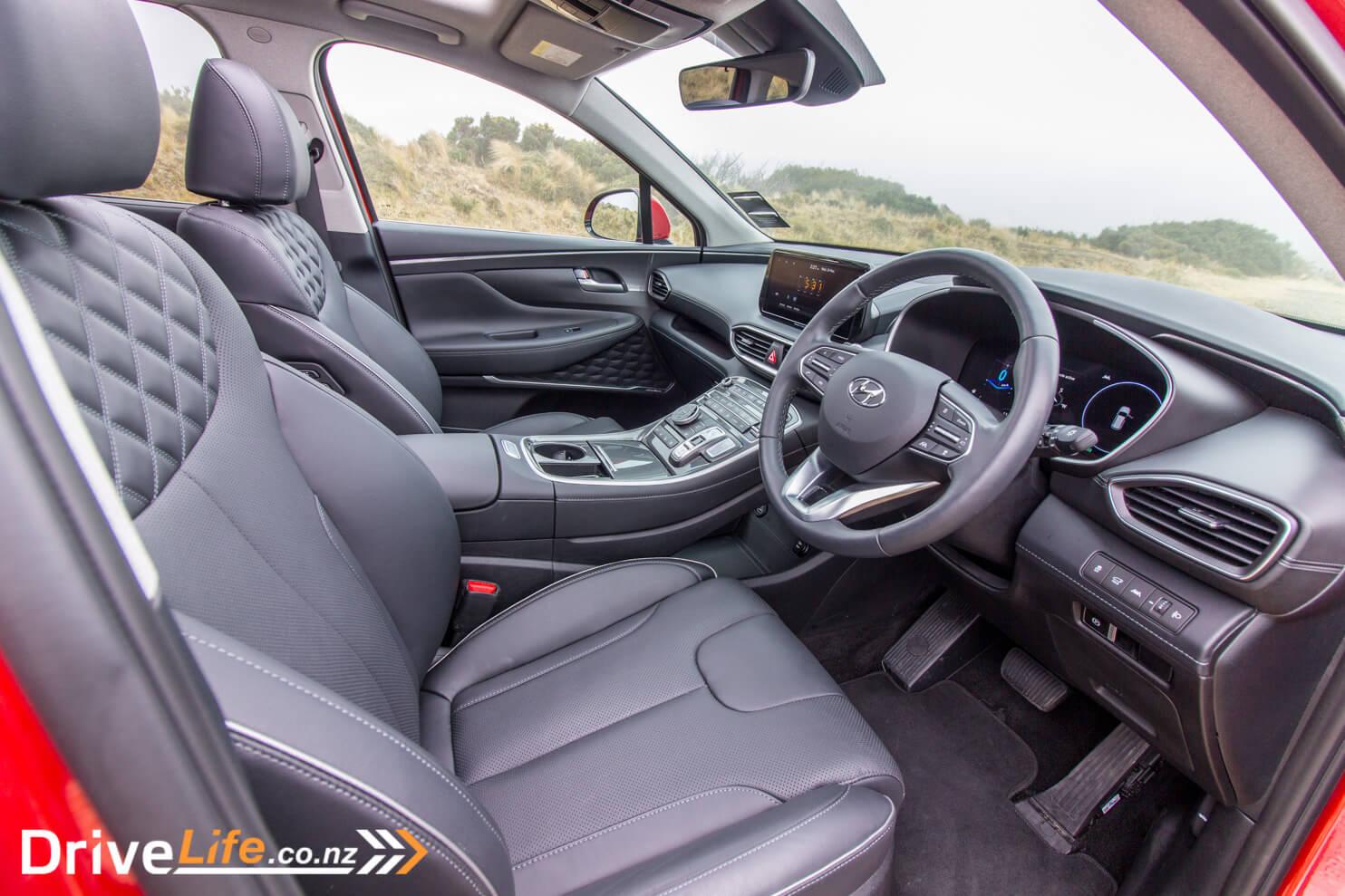
2.2L ‘R Series’ Diesel Engine
The 2.2-litre ‘R Series’ CRDi engine has been upgraded and is now more powerful and fuel efficient. With 148 kW of power, and 440 Nm of torque this engine is now paired with a newly developed 8-speed dual clutch transmission. This powertrain option offers an improved 2,500kg braked towing capacity.
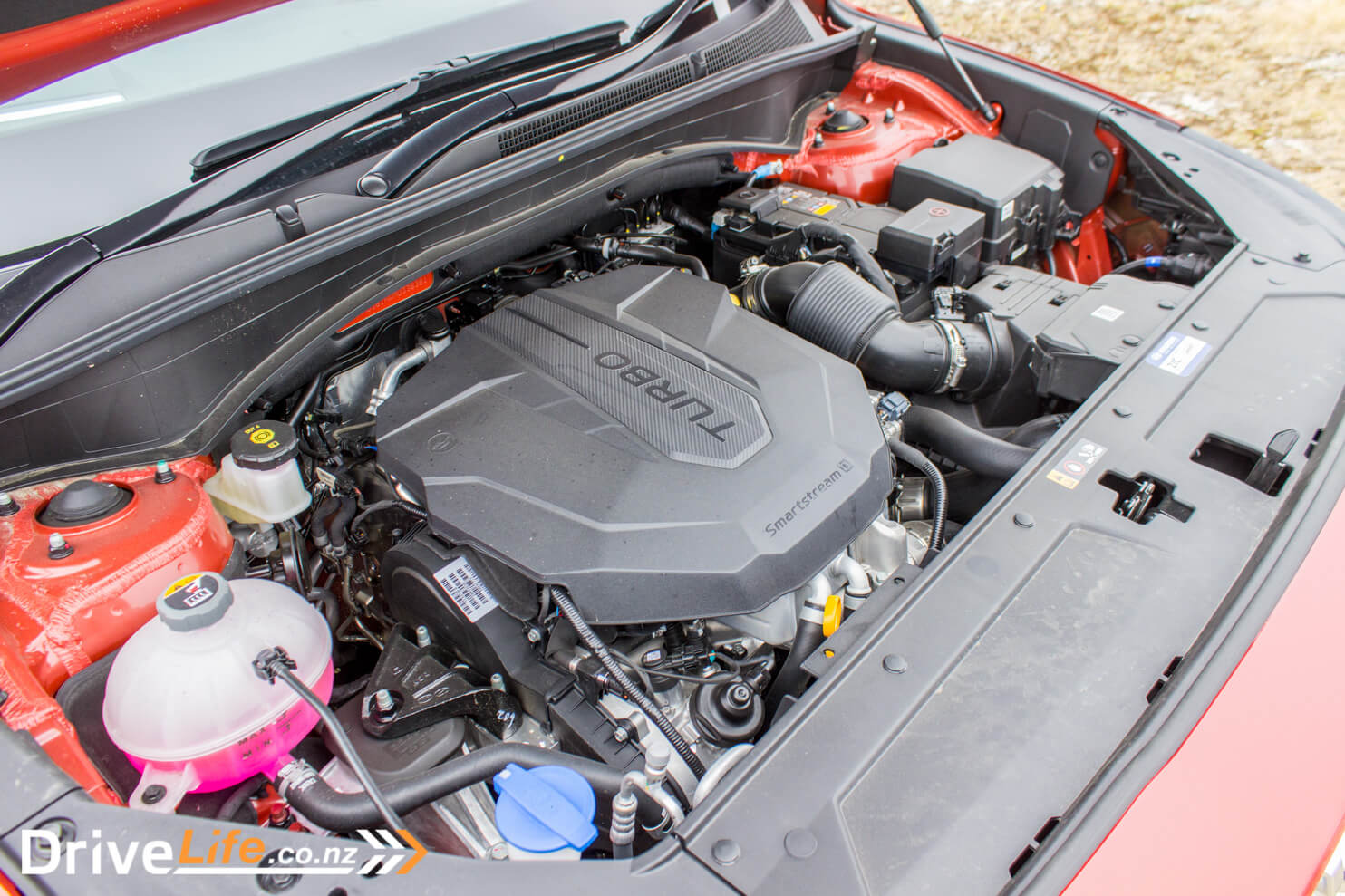
2.5L ‘Theta III’ MPi Petrol Engine
The latest Hyundai ‘Theta III’ 2.5-litre petrol engine delivers 132 kW of power, 232 Nm of torque and is available with a 6-speed automatic transmission.
3.5L ‘Lambda II’ V6 MPi Petrol Engine
For drivers wanting maximum power, the 3.5 V6 ‘Lambda II’ engine is an easy choice. Outputting 200 kW of power and 332 Nm of torque, this V6 engine is paired with an 8-speed automatic transmission for a 2,500kg braked towing capacity.
The Santa Fe will be available in eight different exterior colours: Phantom Black, White Cream, Typhoon Silver, Magnetic Force, Rain Forest, Lava Orange, Glacier White, Taiga Brown and Lagoon Blue. It comes with a black interior, however a dark beige leather interior option is available for special order on Elite and Limited models.
| Variant | Entry | Elite | Limited |
| 2.5L MPI Petrol AWD | $62,990 | $73,990 | $82,990 |
| 3.5L MPI V6 Petrol 2WD | $82,990 | ||
| 2.2L Diesel AWD | $69,990 | $80,990 | $89,990 |
You can read more about the Santa Fe on Hyundai New Zealand’s website.
First Impressions Of The 2021 Hyundai Santa Fe Limited
In Lava Orange, on the whole, our test car looked excellent. It was the front that was the galvanising decision for people; that grille was considered just too big. I didn’t mind it as much, but certainly hope they don’t go overboard on the next model and make it even bigger (cough! BMW cough!).
In saying that the grille may be on the too-large side of things, but the light treatment looks excellent. The combination of narrow main beams and then larger DRLs, fog and high beams give the car a distinct look while also giving it a nice bit of unique styling. It’s certainly hard to miss on the road.
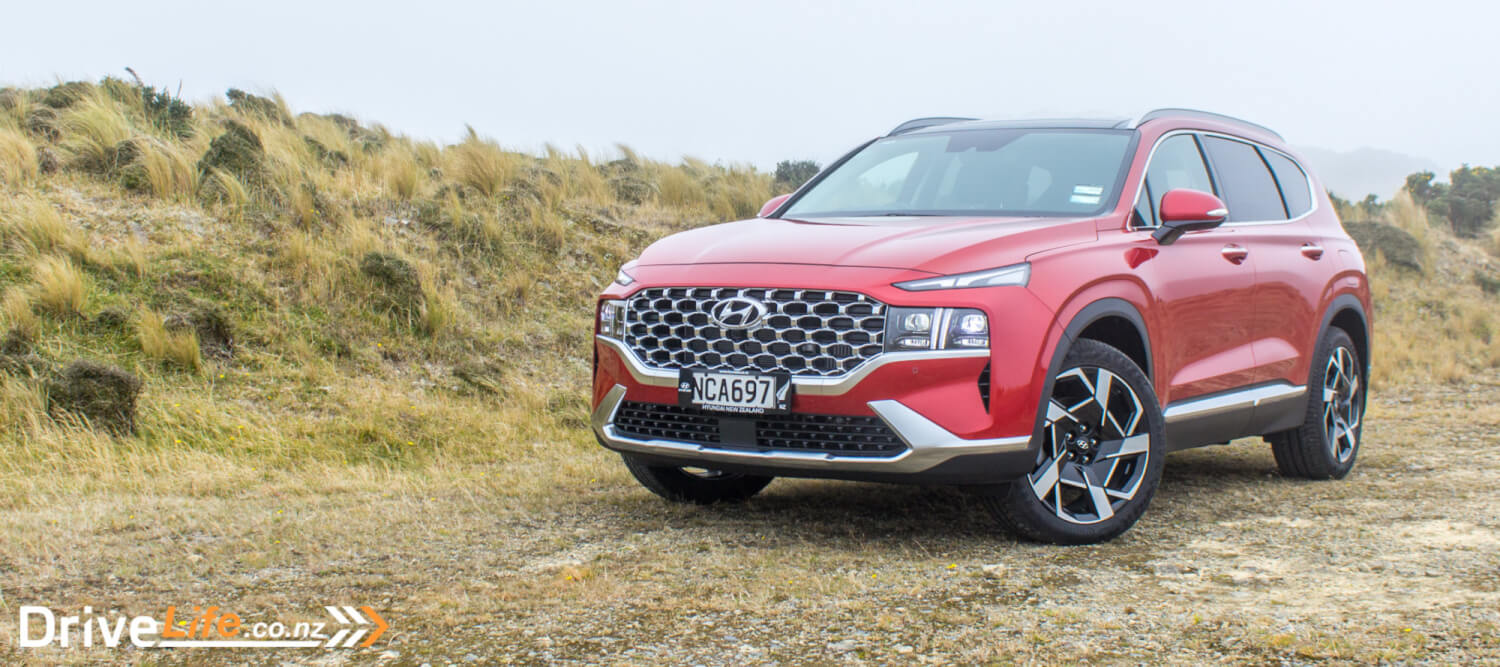
Hyundai says that, “Each side section of the new Santa Fe is characterised by a seamless line that connects the DRL to the taillights, giving the car a sensuously sporty look.” I’ve got to say, side-on it’s all very Santa Fe-ish; long, tall and nicely proportioned. There’s those wheels too, which look superb. The plastic wheel arches on the Santa Fe don’t look like they’re there for looks only; it may not have a ladder chassis, but the plastic wheel arches allude to the fact that it still has some base capability in the rough stuff. Rough stuff meaning the ski fields or boat ramp, of course.
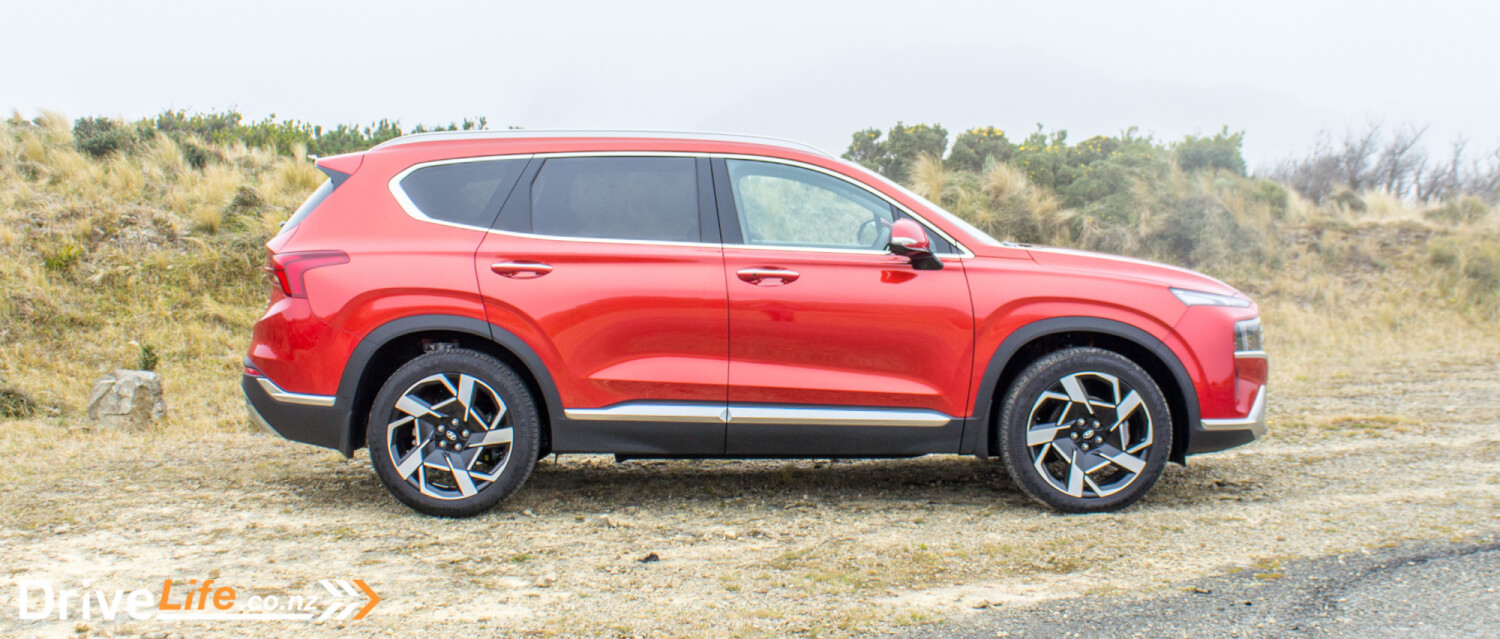
The rear of the car doesn’t look too far different from the previous model, until you get them side by side, then it’s pretty obvious. The previous gen suddenly looks old fashioned and out of date, and the exhaust tips are now hidden. So overall, Hyundai have done well with the design of the 2021 Santa Fe Limited. Clean lines but with enough individuality, and yet still looks like it’s an expensive car.
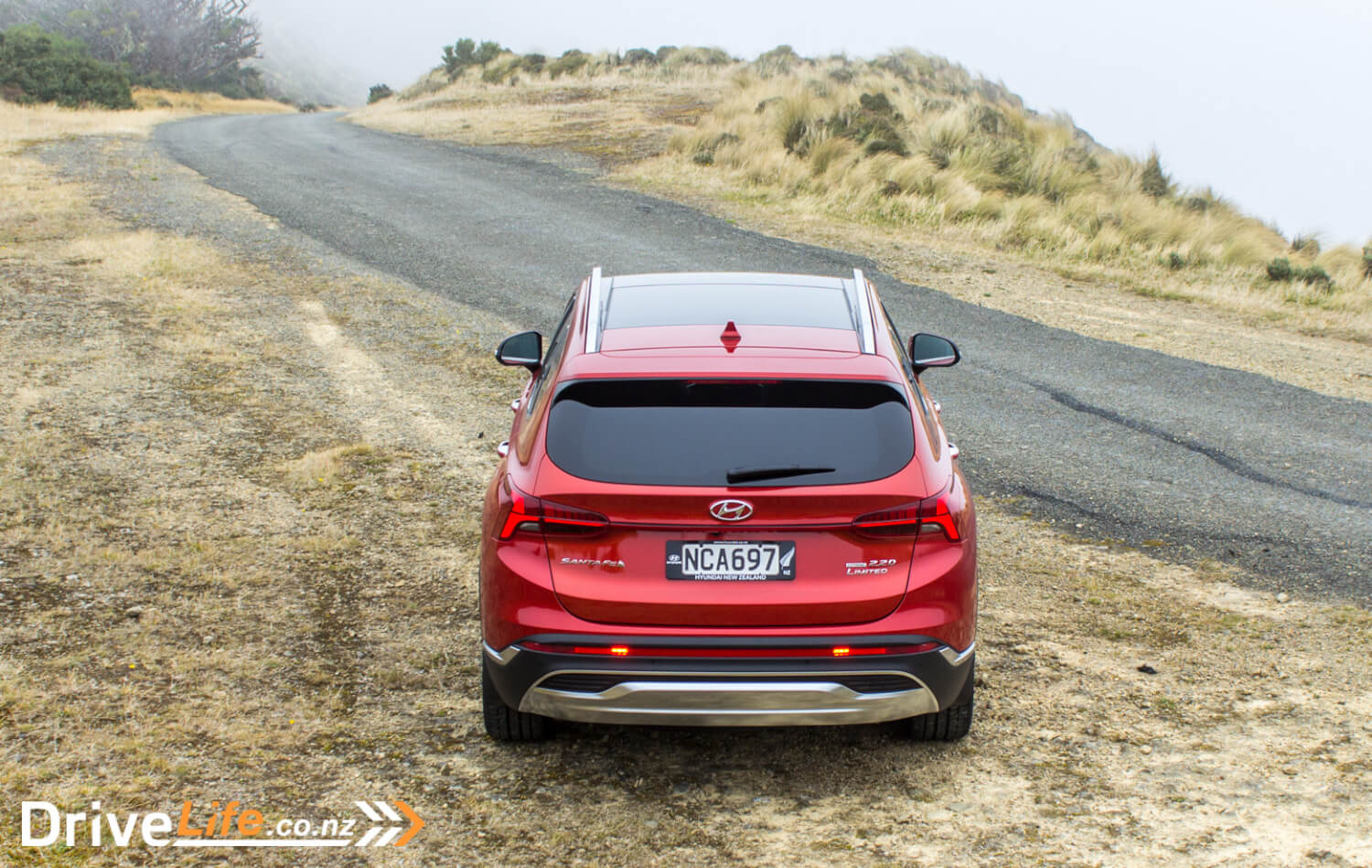
What’s The Interior Like On The 2021 Hyundai Santa Fe Limited?
There’s lashings of fake carbon fibre in the cabin, on the doors, dash and centre console. Better than boring black plastic, I guess. To lift not only the lightness in the interior but also the perceived quality, the headlining is a knitted one, and man it looks good. Feels good too, and your passengers will want to touch it.
Down low, the centre console is quite, shall we say eye catching. It’s big, in your face, and loaded with buttons. You almost feel like a bit of a fighter pilot in the Santa Fe. Some extra buttons here that you wouldn’t normally see are for the transmission. There’s no lever, just buttons to change gear, very much like the Kona EV.
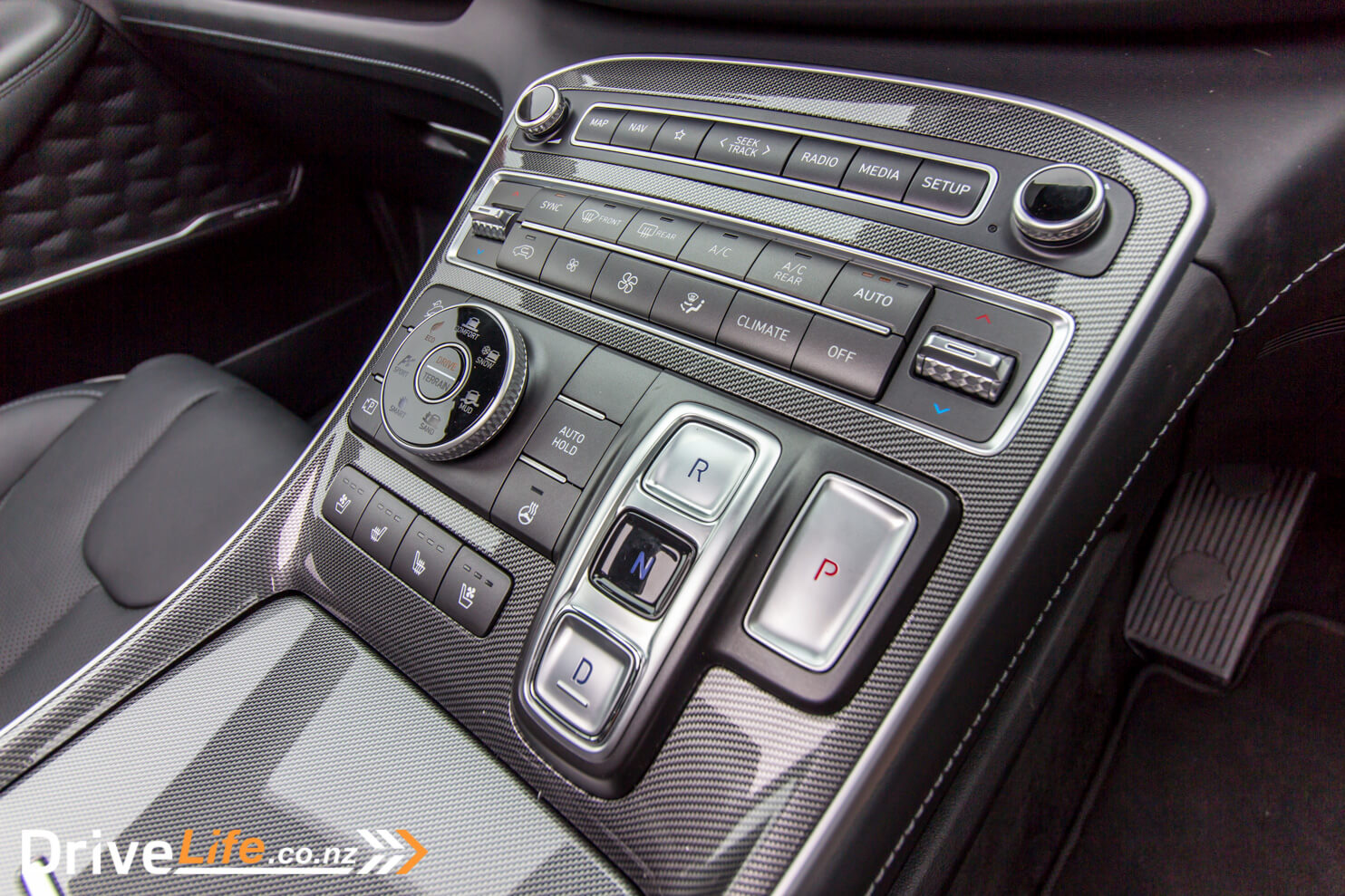
The console itself is pretty high too, and that does mean a huge amount of storage space underneath it, very much like what Honda is doing. Underneath there’s also a single 12-volt socket and a single USB port. At the rear of the centre console is a deep cubby where you could comfortably fit a couple of SLR cameras.
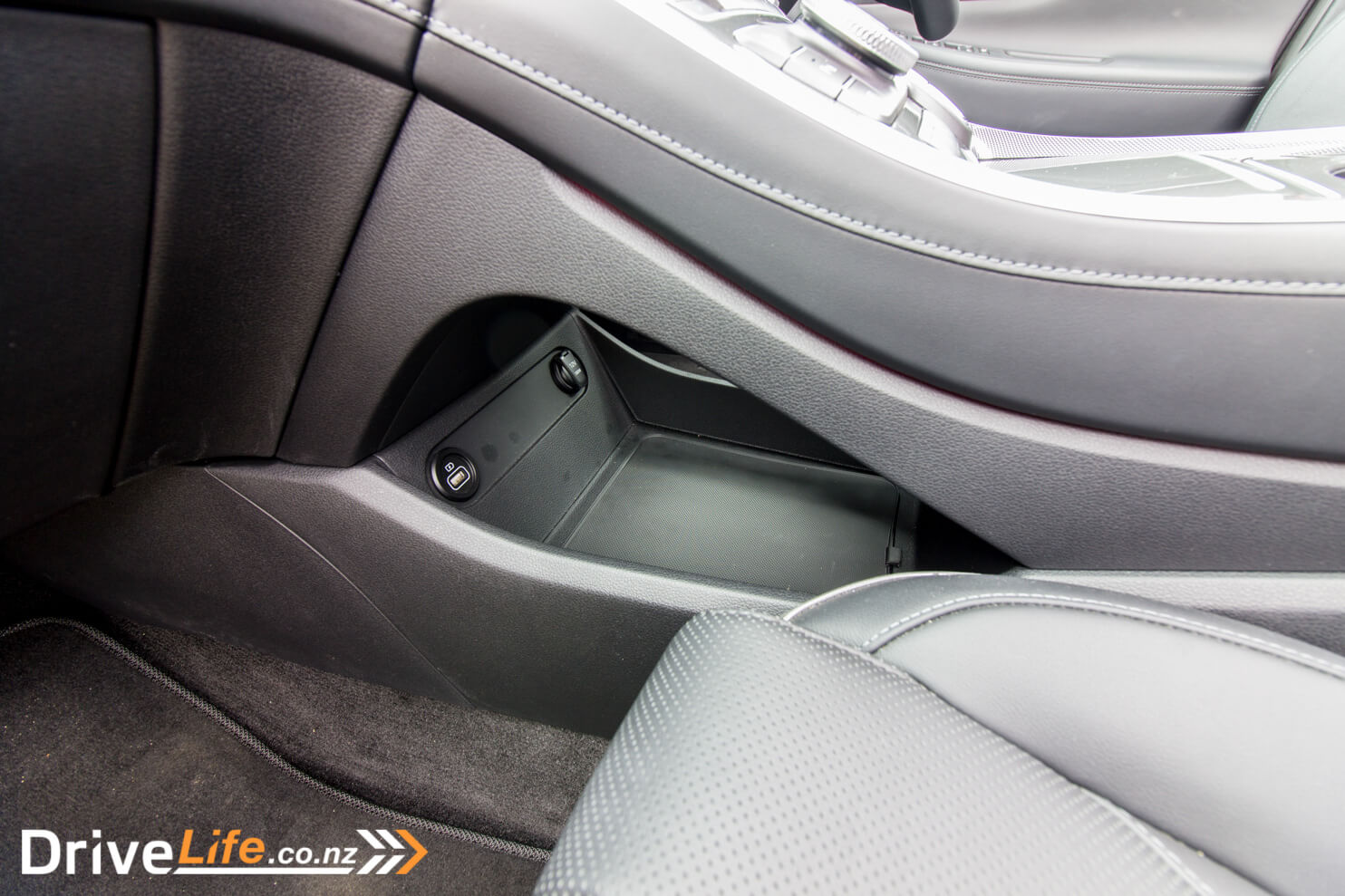
Still on the centre console, there’s a Qi wireless phone charging slot. It’s vertical, which feels strange initially but after a while it’s second nature to just slide your phone down into it. It has a hinged cover halfway down, so if you aren’t using the Qi charging slot or don’t have a phone that’s capable, you can still use this as another place to store a few odd things. Once your phone is in the slot, there’s a wireless charging light just in front of it to let you know it is actually charging, and there’s also an indicator on the central display telling you the same. Just in front of the Qi light on the centre console is another standard USB port.
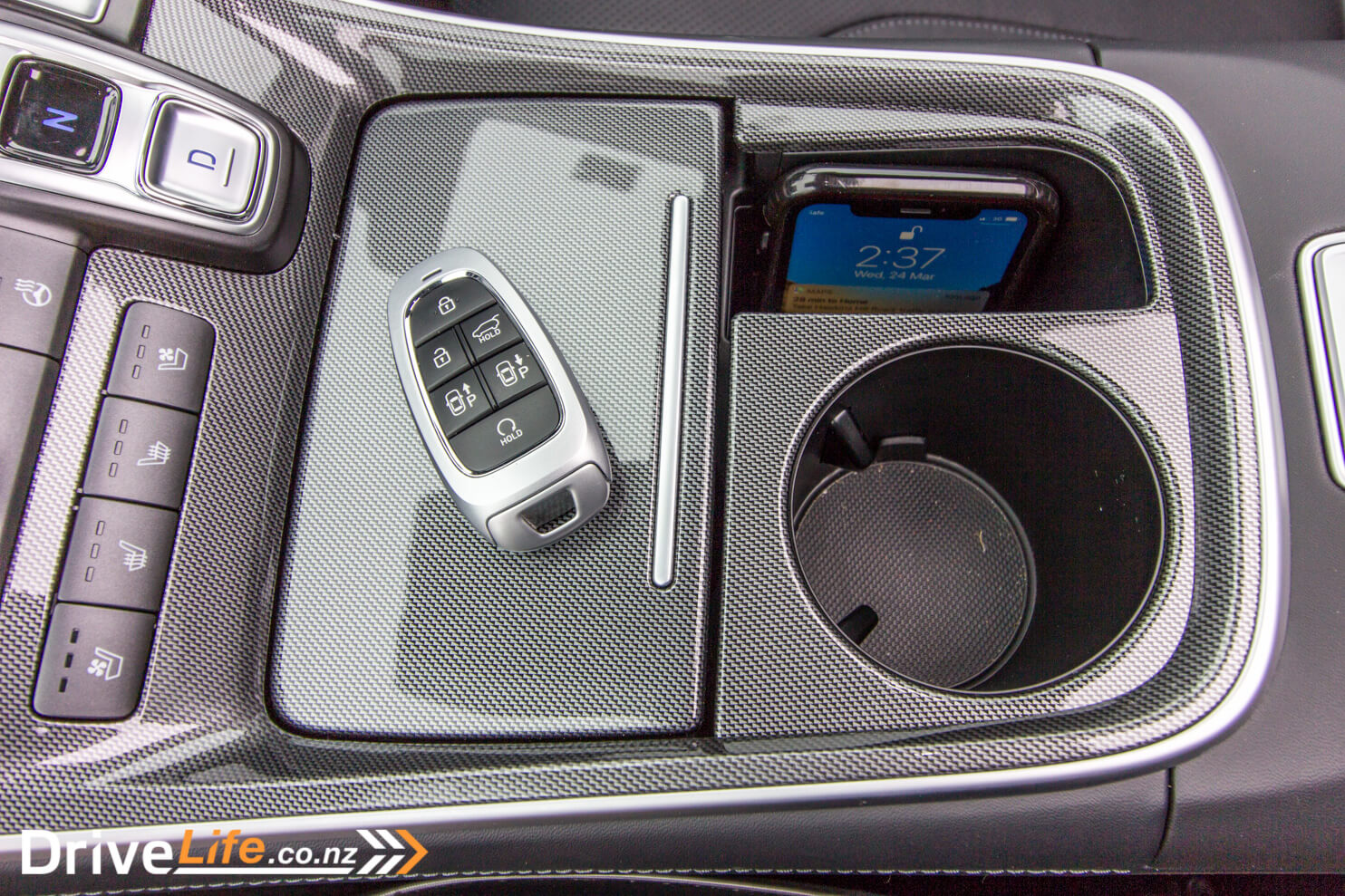
Above the glovebox is a long shelf, perfect for a cellphone or probably three of them. The glovebox itself is large too. As you can tell, storage space is not an issue in the Santa Fe.
The interior overall is pretty light, not just from the beige knitted headlining but also – in the Limited model at least – there’s a massive panoramic sunroof going from the front of the car to past the second row of seats. It’s an electric tilt/side unit, and there’s also an electric blind. It all adds to the feeling of space, and that’s not just a feeling, either; the Santa Fe is a big car and there’s plenty of room inside for all.
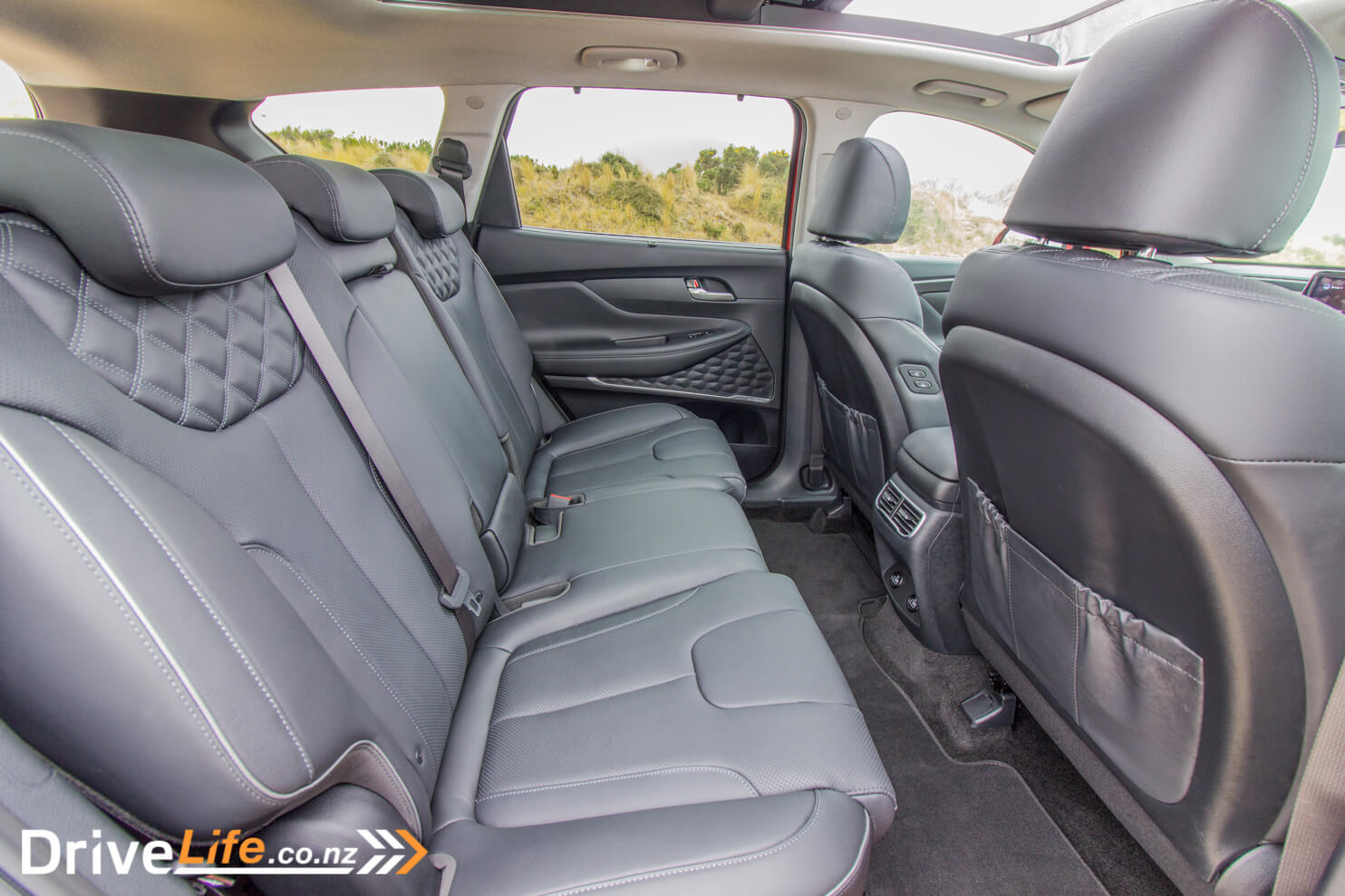
Second row passengers are well looked after with plenty of headroom, rear window blinds, two USB ports, and heated seats.
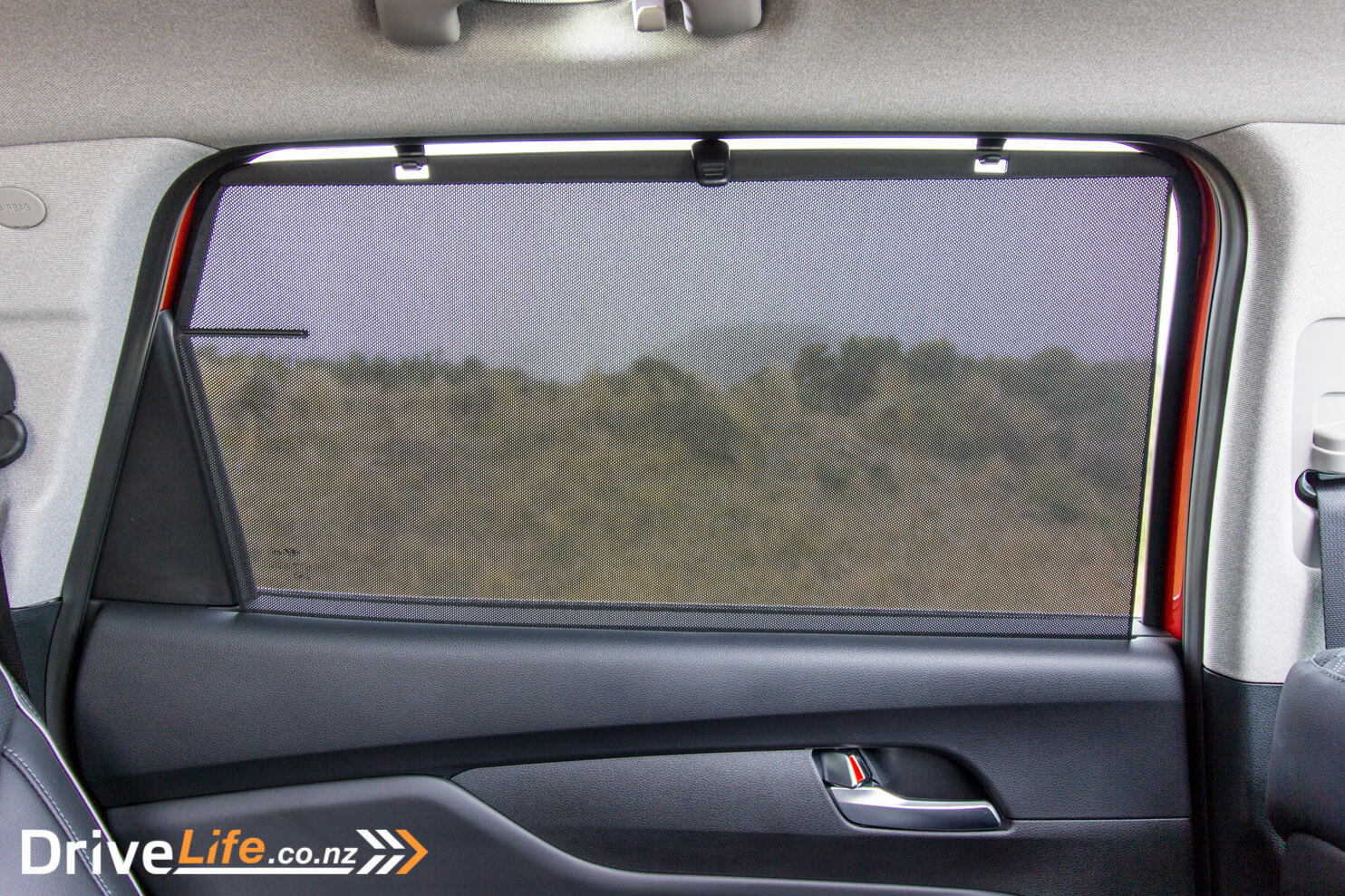
Those in the 3rd row have one 12-volt socket, one USB port, a fan control for the air con and two air vents. There’s not masses of space for third row passengers, but the rear seats do slide forward to give them some extra room at least. It’s still not the place for two 6”2 teenagers to sit on a trip to Auckland, though.
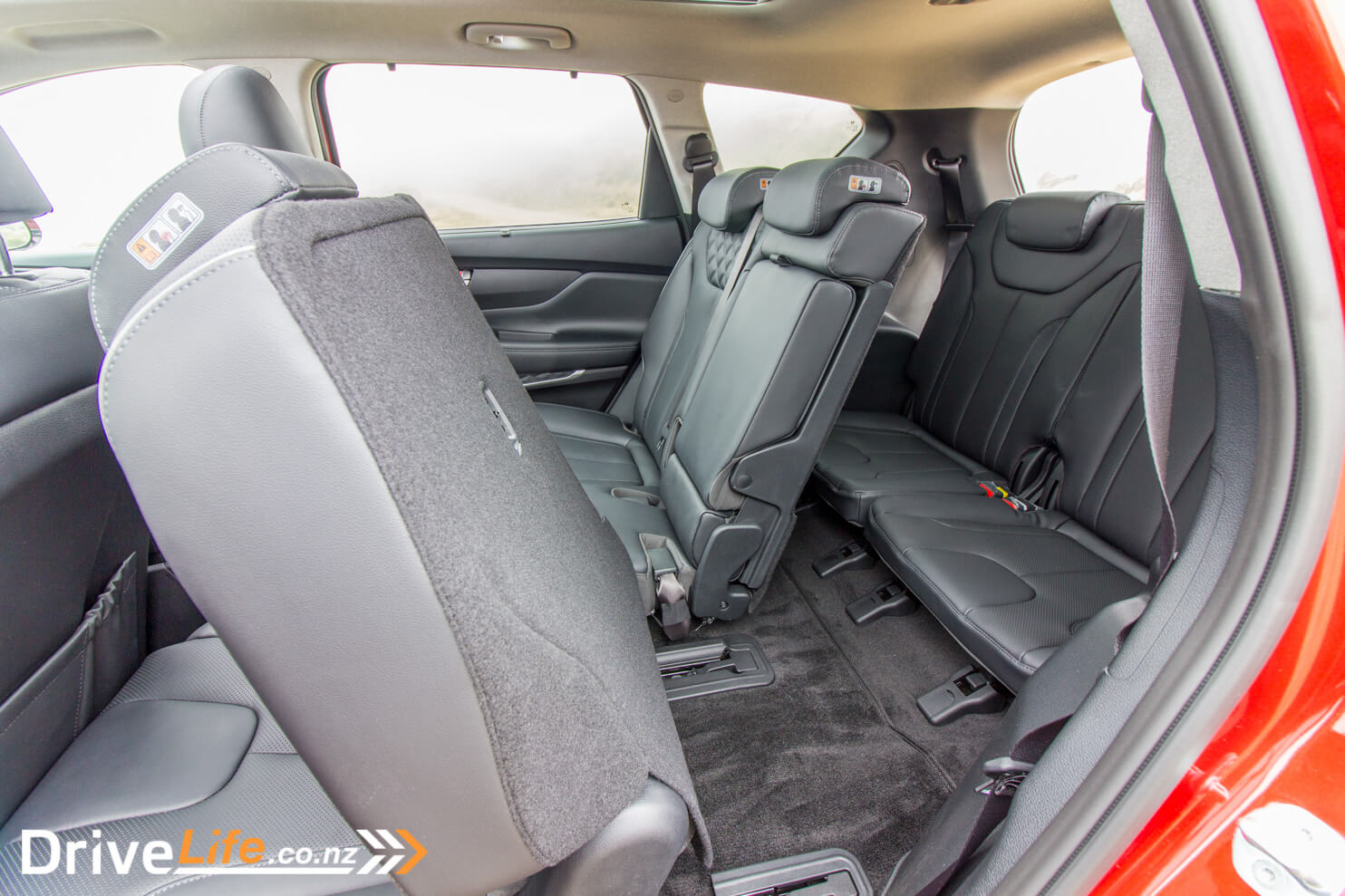
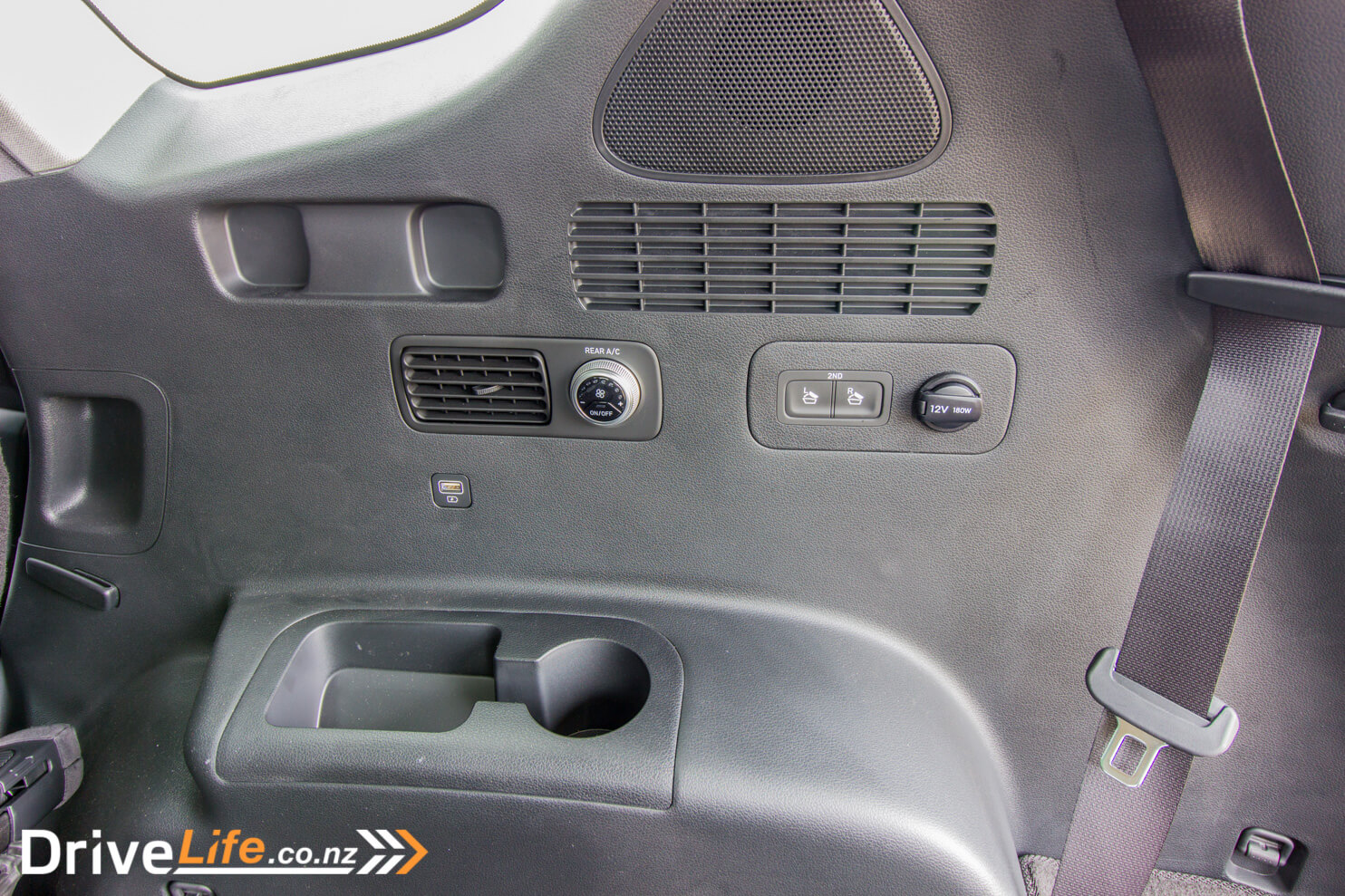
Space-wise, the boot is relatively spacious at 571 litres with the third row up, although as usual with the third row up, storage space is limited.
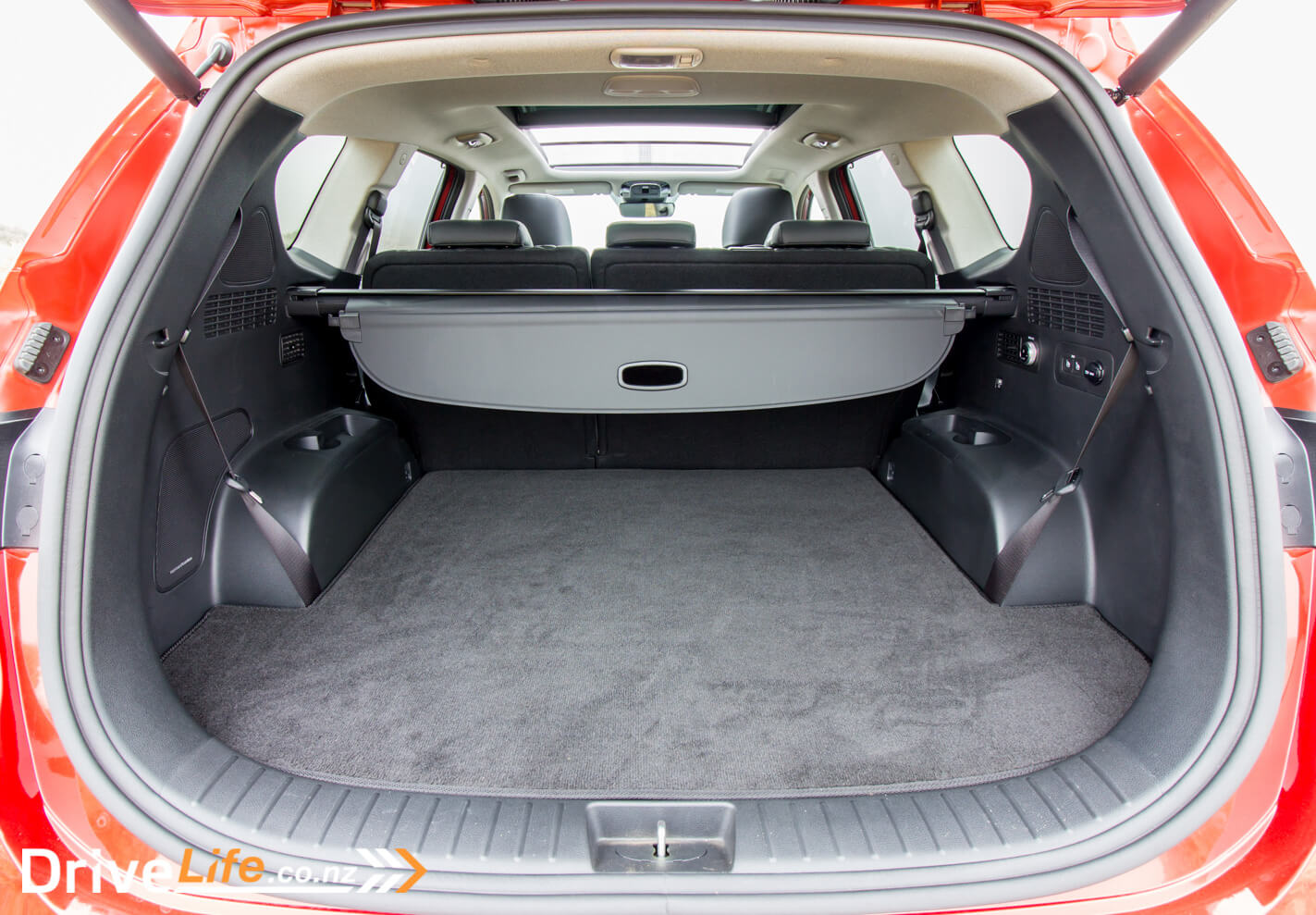
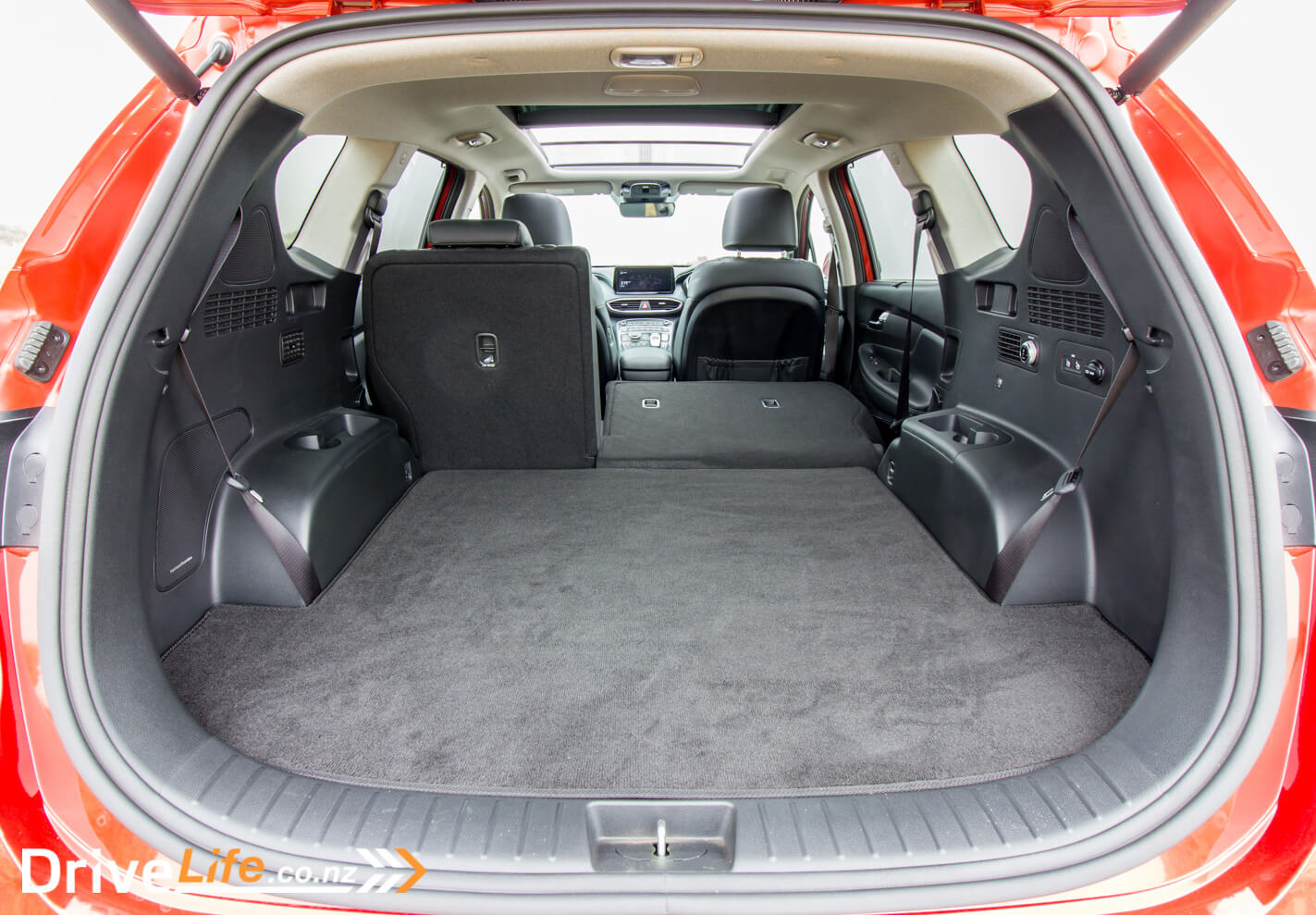
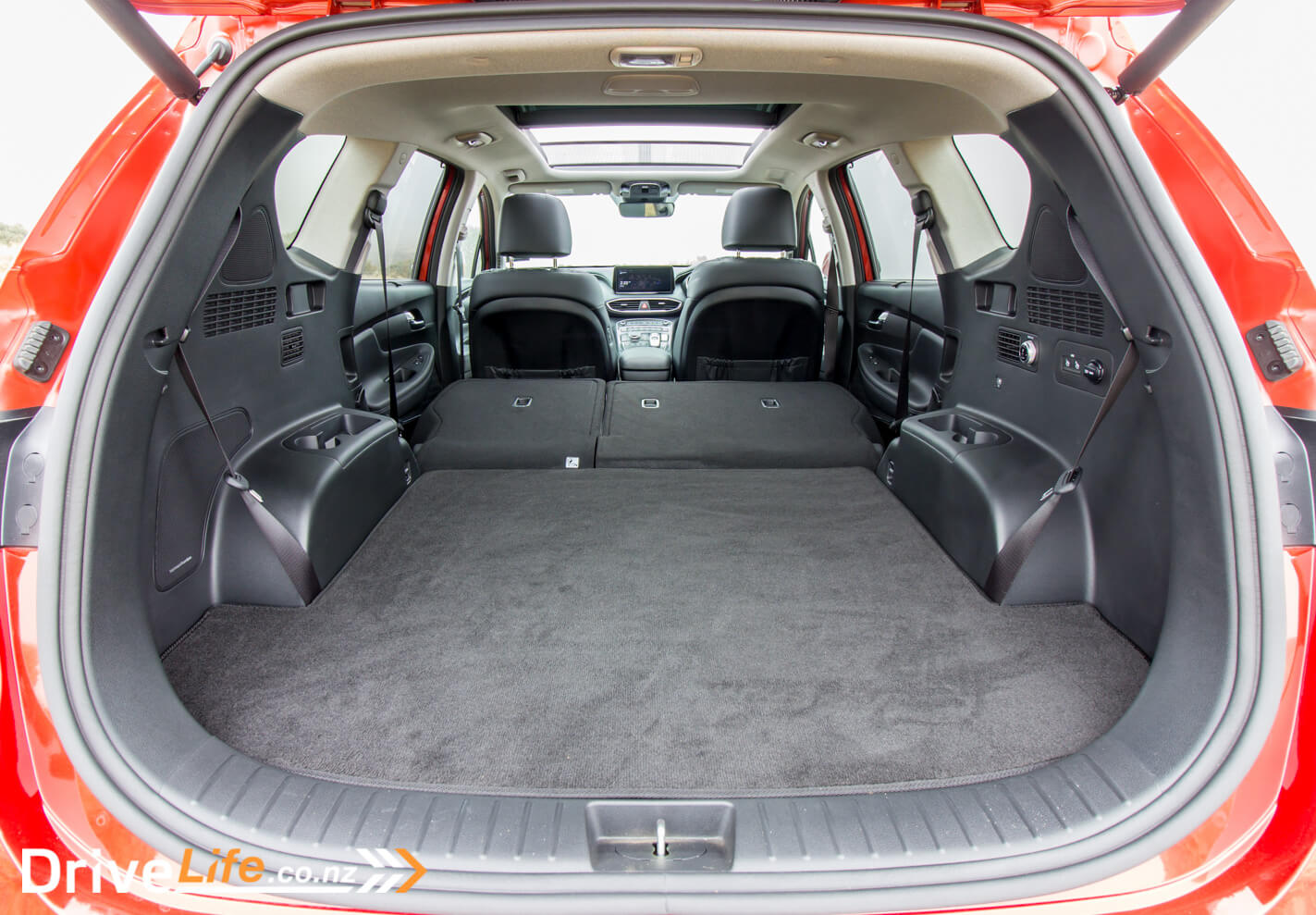
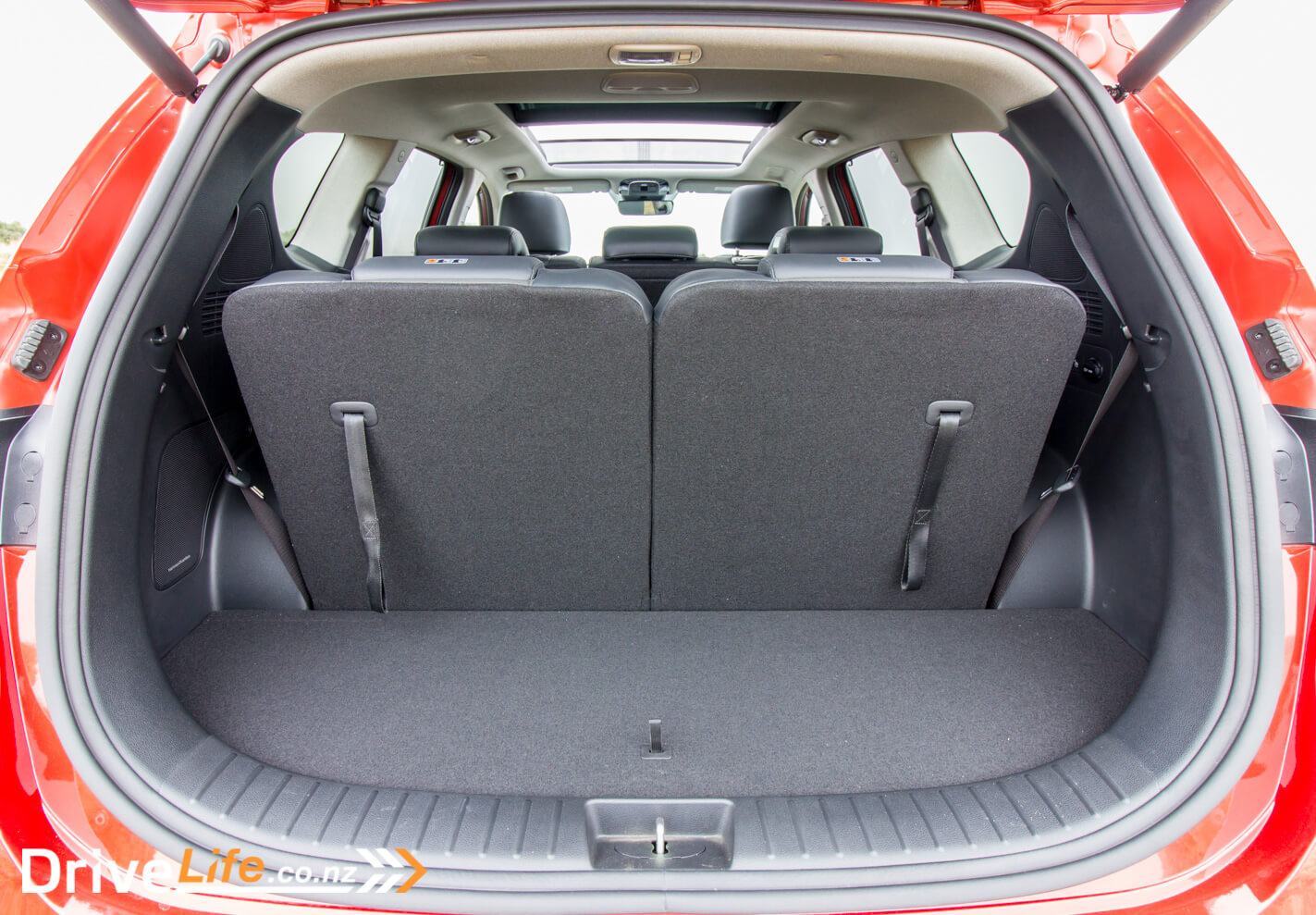
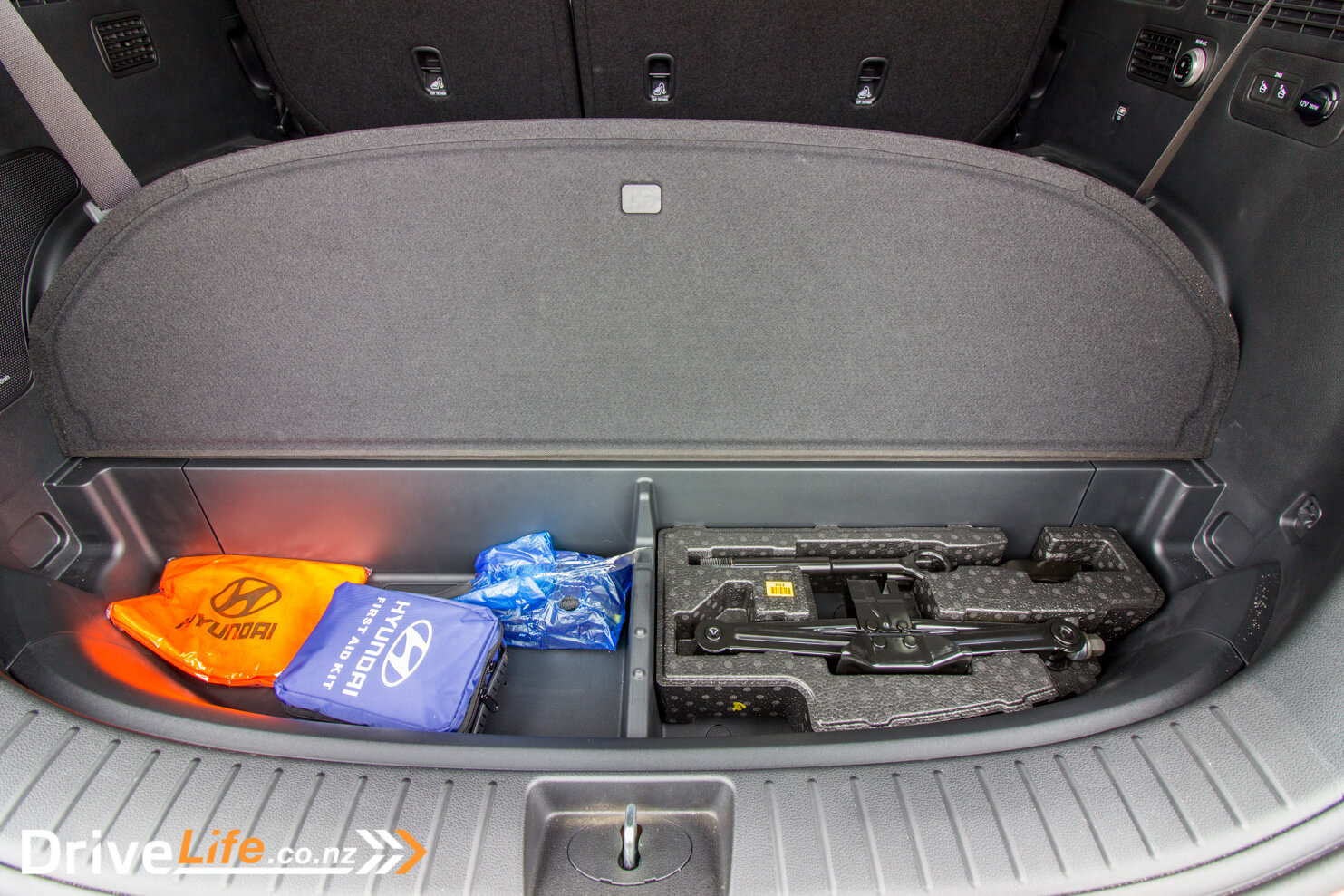
What’s The 2021 Hyundai Santa Fe Limited Like To Drive?
It’s been a while since I’ve been in a diesel, so on picking up our test car it was nice to see the distance to empty showing at 829Km.
I recall the launch of the last gen Santa Fe and simply how smooth it was. The new model is not massively better, but it would be hard to see how it could be. The 2021 Santa Fe exudes refinement; the engine is a gem – so smooth, so quiet and still plenty of power for overtaking.
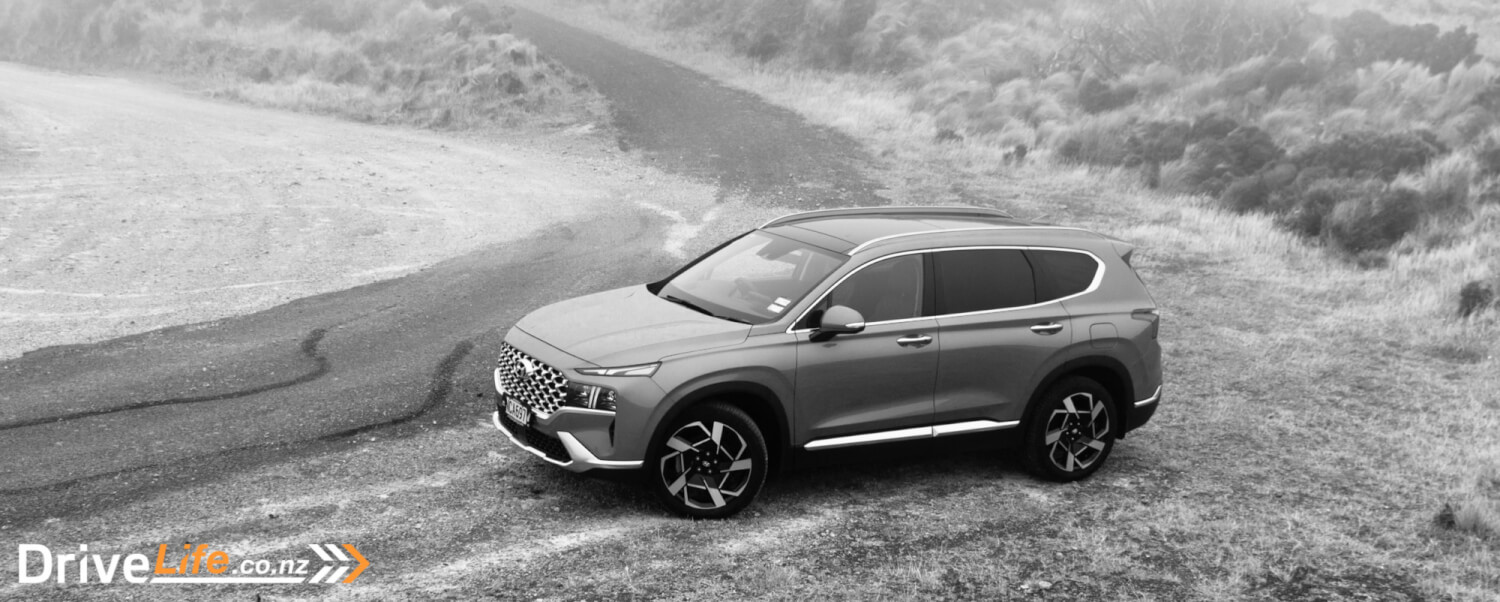
There’s so much torque at hand too, that I drove the car in Eco mode for almost the whole week, and didn’t notice it. Generally, switching a car into Eco mode can be a frustrating drive due to a lack of performance, but not for the Santa Fe, it laps it up. Leaving it in Eco mode was made easier by the drive mode selector; it’s a physical rotary dial and not buttons, so you can select a drive mode and it will stay there, even when you exit the car and then get back in. Too often this doesn’t happen with other cars.
Drive modes are carried over from the previous gen; Select from Confort, Eco, Sport, or Smart. That’s the drive modes, then there is the new Terrain button just below Drive modes, and this allows you to select Snow, Mud, or Sand. Something for everyone, it seems.
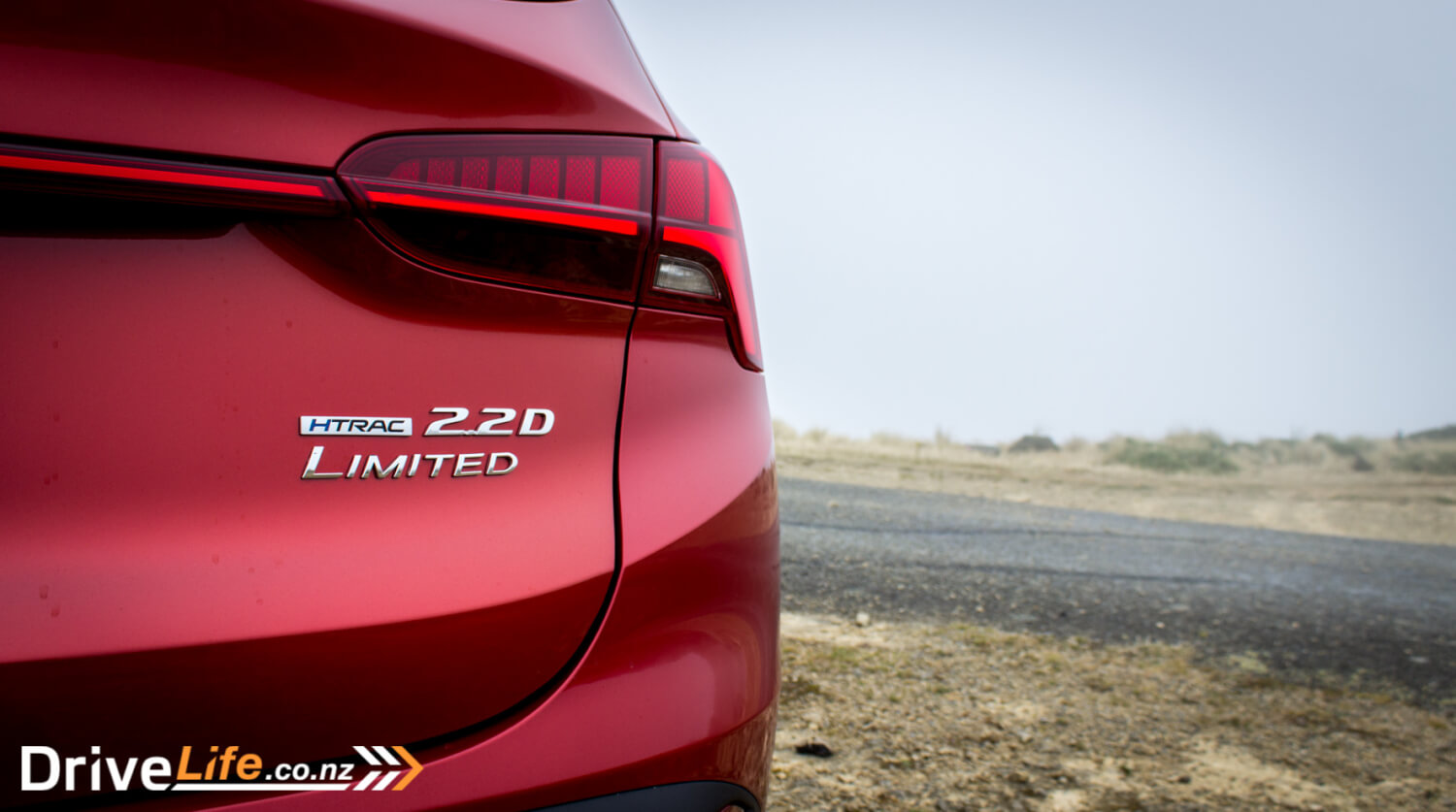
I want to get back to that engine, since it’s so good. 100Km/h will see 1,500rpm on the rev counter, and motorway travel is almost silent. Not just the engine either – there’s very little wind, road or tyre noise inside the car. Up hills the engine can become noisier, but it’s never bad. This diesel Limited version of the Santa Fe can get to 100km/h well under ten seconds, and it’s all drama-free. The permanent all-wheel drive helps here, but you do get a few chirps out of the tyres on full-throttle acceleration with the car in Sport mode. It does run out of puff at the top end, but then most diesels do. Honestly, this engine is a great example of just how good a diesel engine can be.
The 2021 Santa Fe is fitted with the latest version of HTRAC, Hyundai’s electronic all-wheel drive system that automatically detects vehicle’s speed and road conditions to control braking between the left and right wheels and apply active torque control between the front and rear axles, in order to ensure stability while driving and cornering on slippery roads. You can actually select an HTRAC view on the dashboard and see the system working, sending drive to whatever wheel needs it.
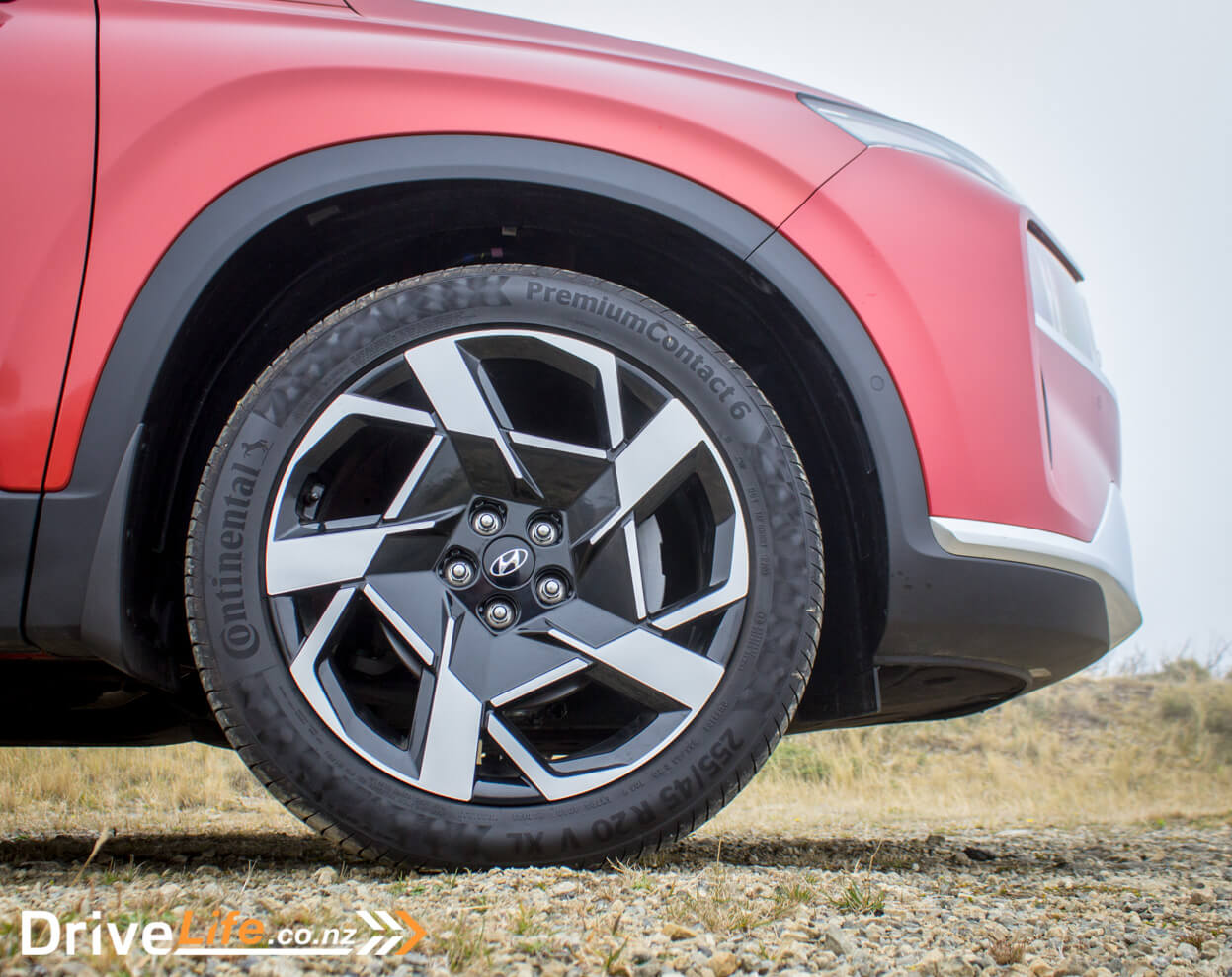
There is a bit of a negative here in driving the Santa Fe Limited, but it’s almost the only thing I could fault the car on. A bit of context; a few weeks ago, I had the 2021 Audi Q5 TFSI (turbo-petrol) on test, and during my week with the Santa Fe, all I could do was compare it to the Q5. Cards on the table, I loved the Q5 and the Santa Fe was so close to the Q5 in overall driving dynamics, it was hard to not compare them. The one downside of the Q5 was the dual-clutch automatic; great on the move, but often jerky at low speeds, as a DCT can be. And the Santa Fe is the same; dual-clutch automatic which is awesome when you are already on the move, but at low speeds or from a start, could be a little jerky, and sometimes indecisive of what gear to select.
So this was a mirror image of my Q5 experience. The Santa Fe had the other occasional blip where, when selecting a gear using the buttons, it would take a few seconds for the car to actually get into gear. Not the end of the world, but exactly like the Q5, it detracted from what was almost the perfect car.
Dual-clutch transmission rant over.
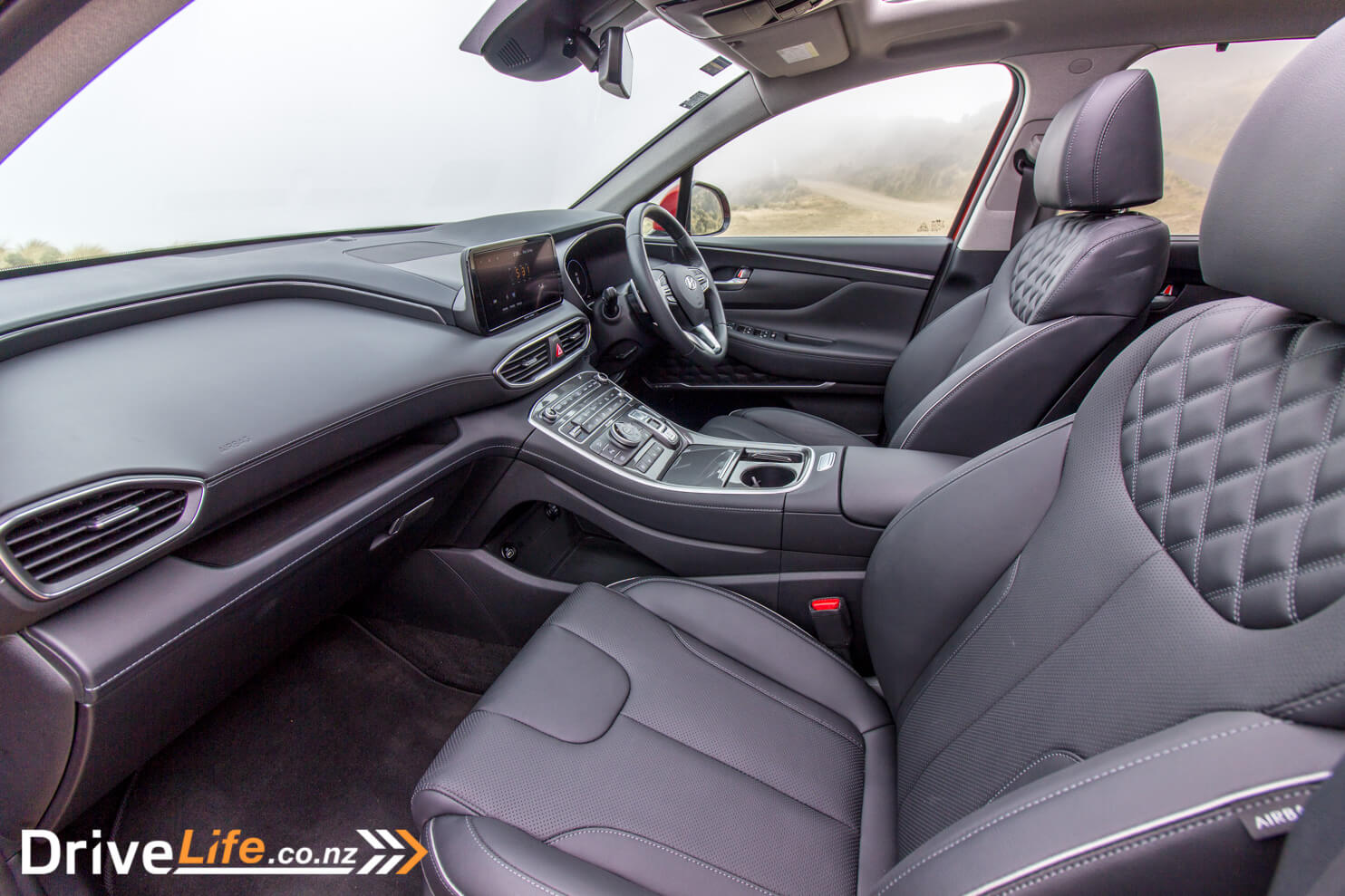
Being the top-spec model, the Limited is loaded with features. There’s self steering which works beautifully, cleaning guiding the car in its lane. We’ve seen some bad examples of this, but the Santa Fe nailed it.
Another very handy features is on the dashboard; when indicating a lane change, the speedo (left side of the dash) changes to a blind spot camera so you can make sure there’s nothing in the lane you want to change into, or say at a roundabout – you can check there are no bikes creeping up your inside. The right indicator changes the rev counter (right side of dash) to a blind spot camera on that side of the car. The only drawback I see of this system is the most New Zealand drivers never indicate. Then the glass half full side of me hopes that by having this system in the Santa Fe, maybe they will start indicating. I live in hope.
Speaking of the dash, there’s some nice customisation available for it. You can choose to have the active dash change with the drive modes, so say you select Sport mode, the dials will change to red. You can also switch this off, and select from 5 dashboards, including one called Cube.
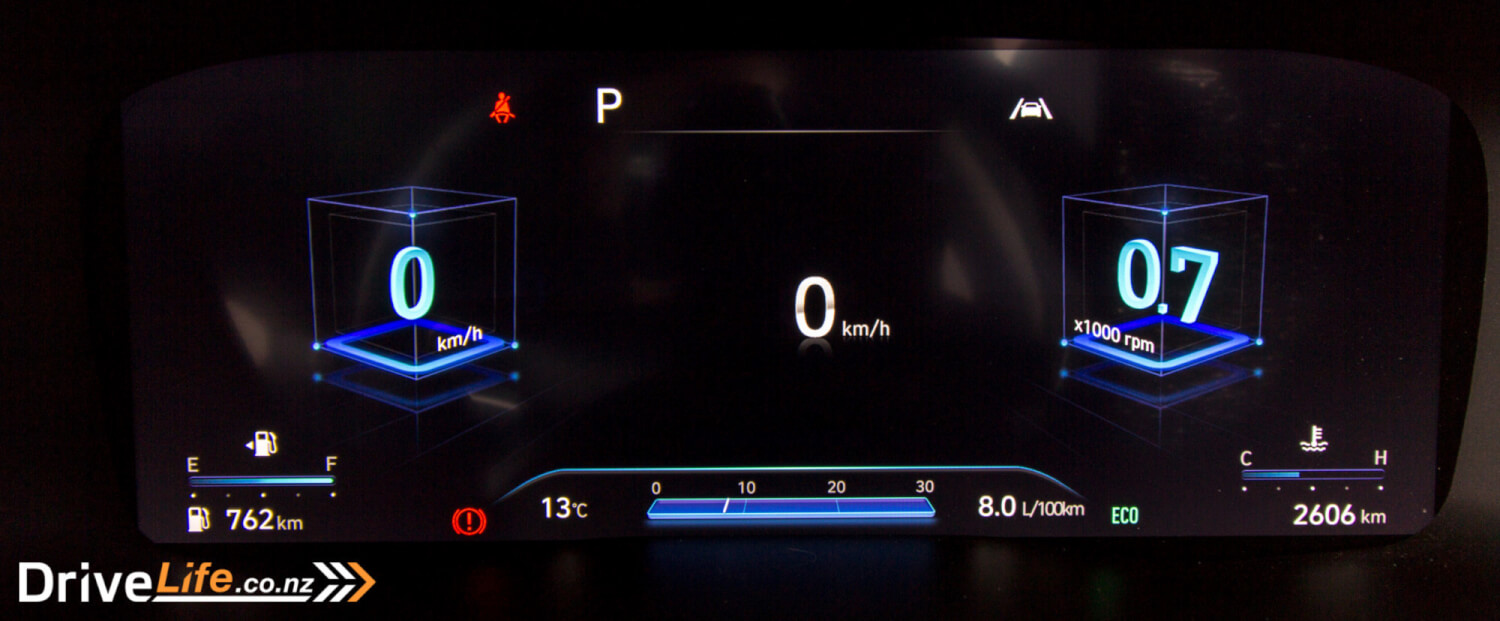
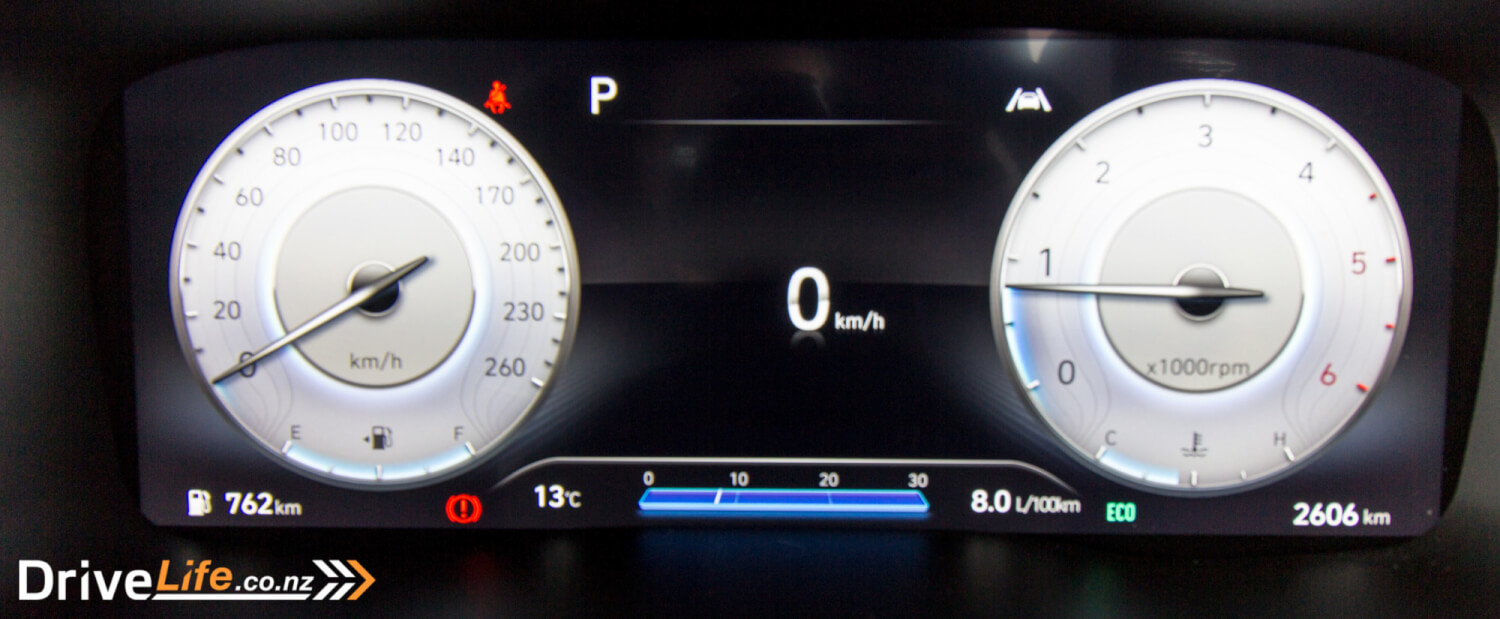

You don’t really need to use the dash in the Limited model as it has a heads-up display (HUD). This is always appreciated and one of those items you instantly miss after moving into another car. There’s the usual info available; current speed limit, your speed, SatNav directions, audio. If you are over the speed limit posted, then the current speed display will flash orange; get up to 10% or more over the limit, and it flashes red. It’s a great way to catch your eye.
But then we come to issue #2 for the Santa Fe; it doesn’t have traffic sign recognition (TSR). This means the speed shown can often be out, especially when going through road works and the car doesn’t pick up the change of speed. Not only that, but our test car often had the wrong limit showing. For example, Ngaraunga Gorge had the car showing a 100km/h speed limit, yet it’s been 80km/h for many years. This issue with wrong speed limits was reflected on other roads too.
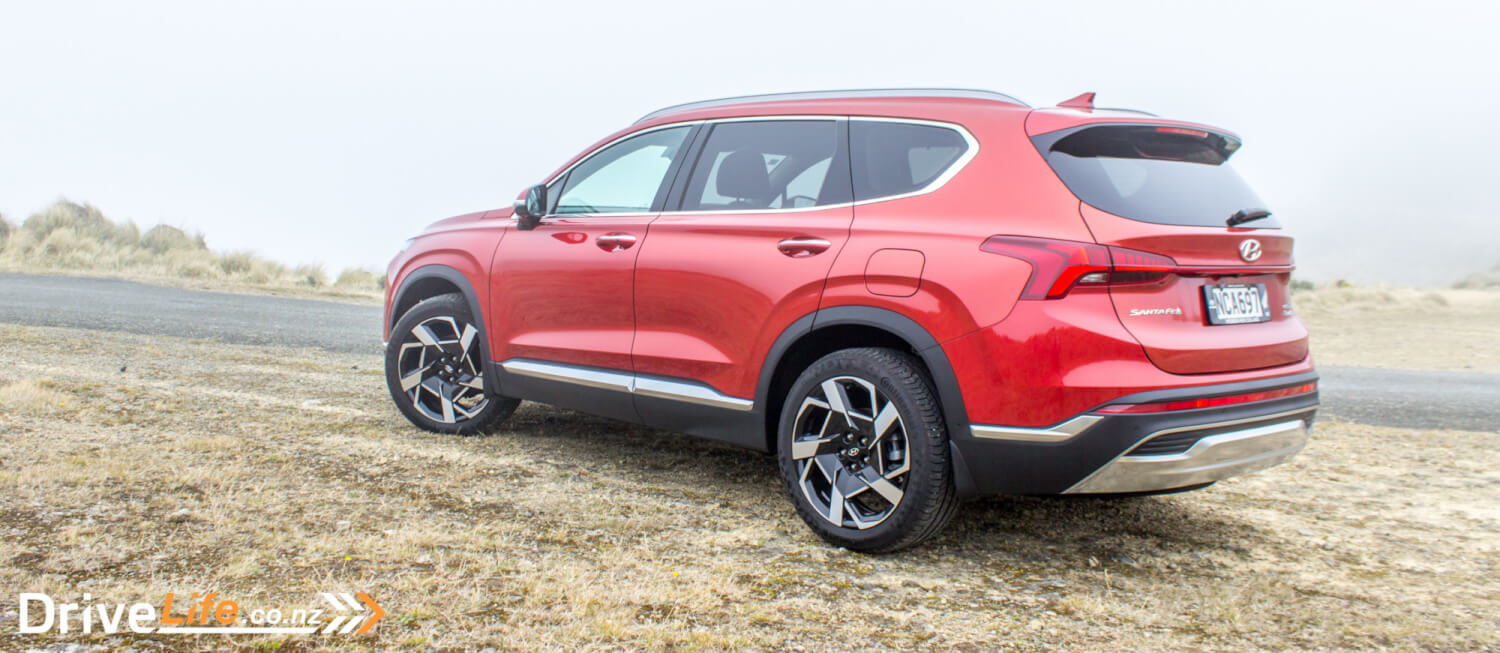
Hyundai have taken the opportunity to add some bling to the Limited model, so you can also choose from a range of sounds in the car instead of listening to music using the Sounds Of Nature option. There’s a small selection here; Calm Ocean Waves, Rainy Day, Fireplace, Lively Forest, Snowy Village, or Open Air Cafe. Fireplace has crackling noises of wood burning, rainy day is rain falling, Forest Snowy Village means you will hear someone’s footsteps crunching through the snow. I’m not sure it would hold people’s attention for too long, but it may be enjoyable for kids on a long journey. A shame that, for example, when you have the fireplace going the display doesn’t show a fire burning, it’s just a static image of a fireplace.
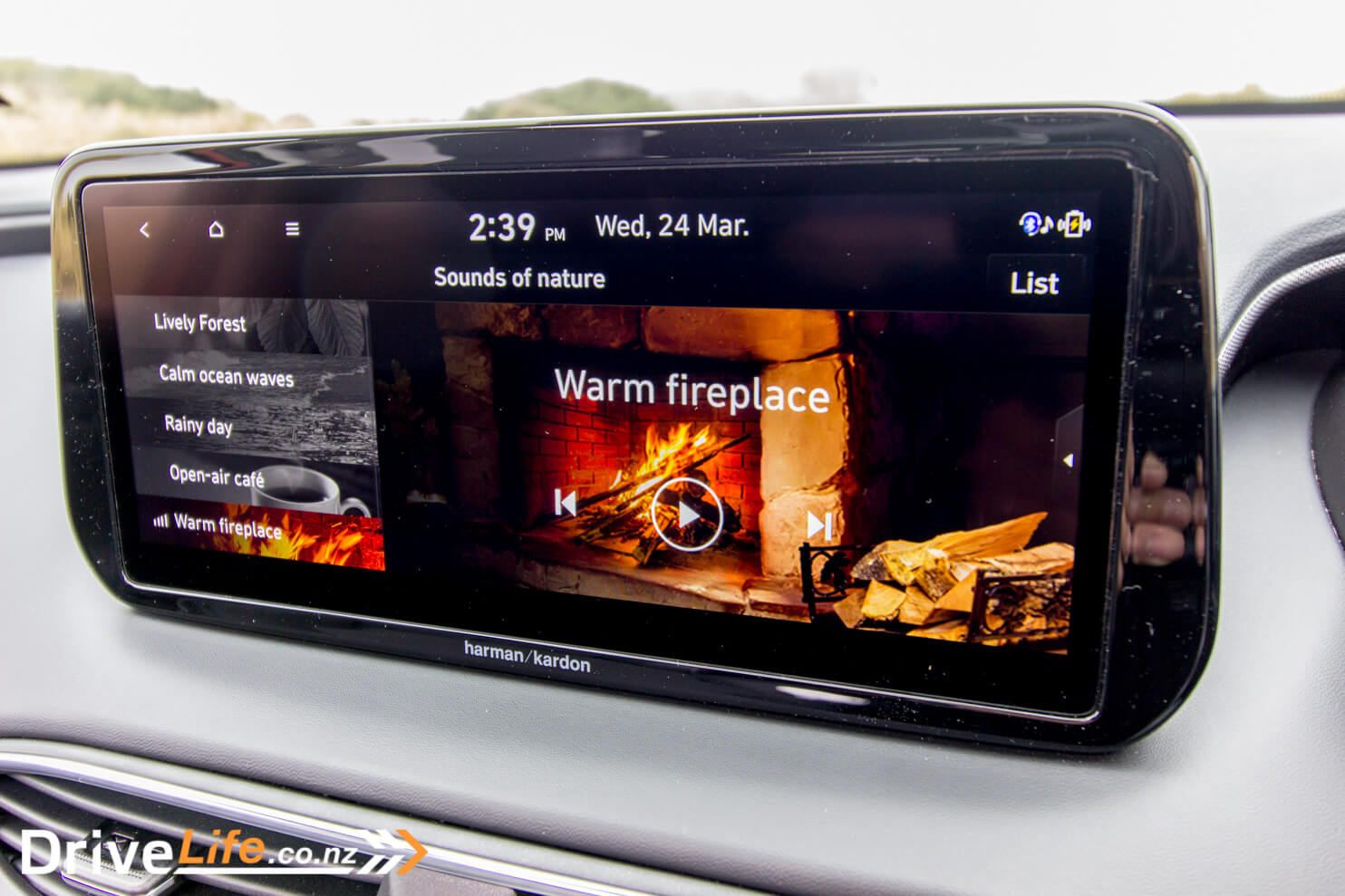
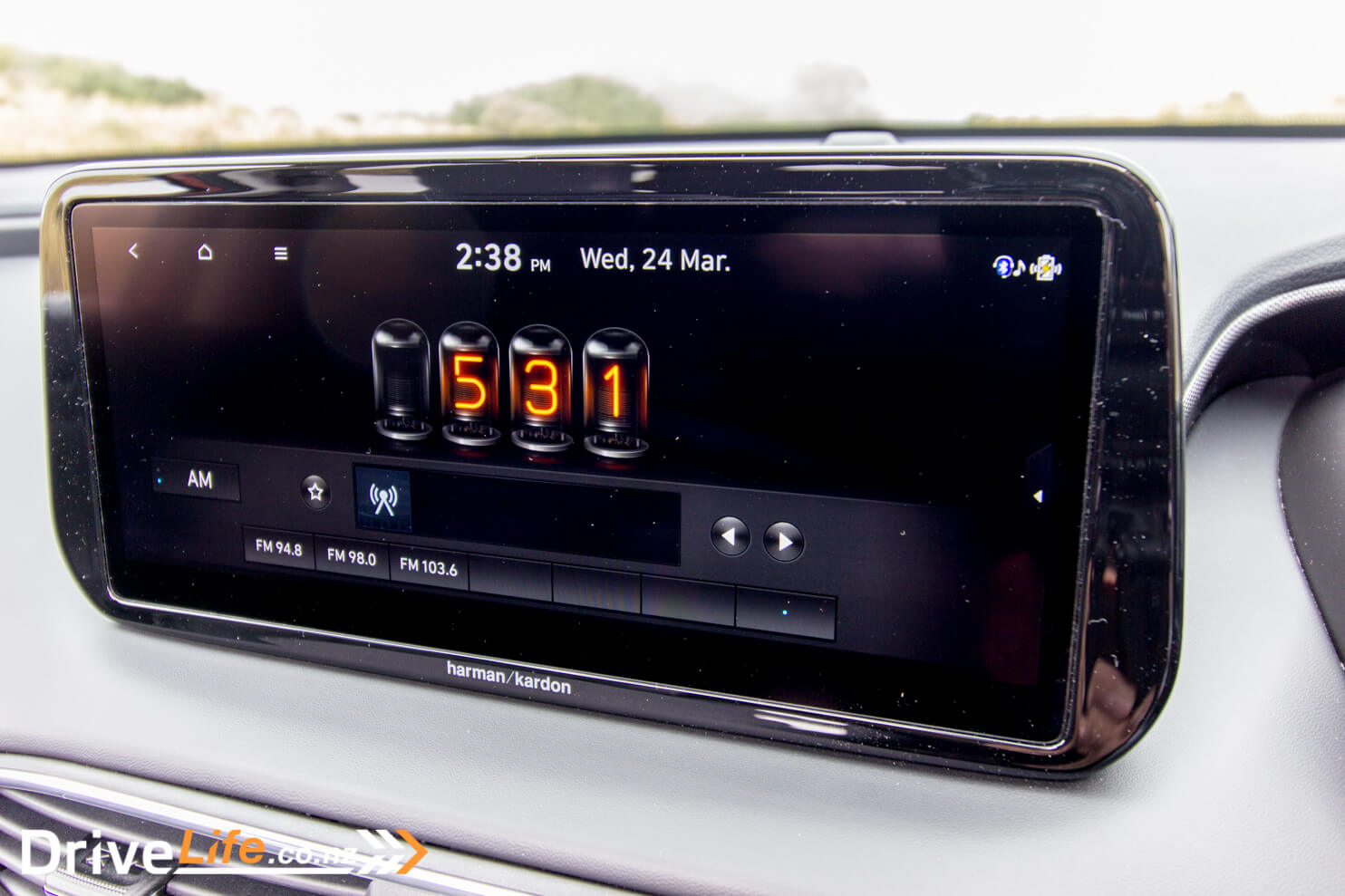
Another feature of the Limited, and one I haven’t seen for a while, is the Remote Smart Park Assist option. This means that if you come back to your car in a car park and some ‘person’ has parked so close you can’t even open your door, you can use the car’s remote to move the car forwards or backwards out of that car park. There’s a bit of a process to this; press the lock button on the remote, then hold down the engine start button on the remote, then use the arrow keys on the remote to move the car. I could see this being quite handy when you really need it, and haven’t seen this option since a BMW 5 Series a few years ago.
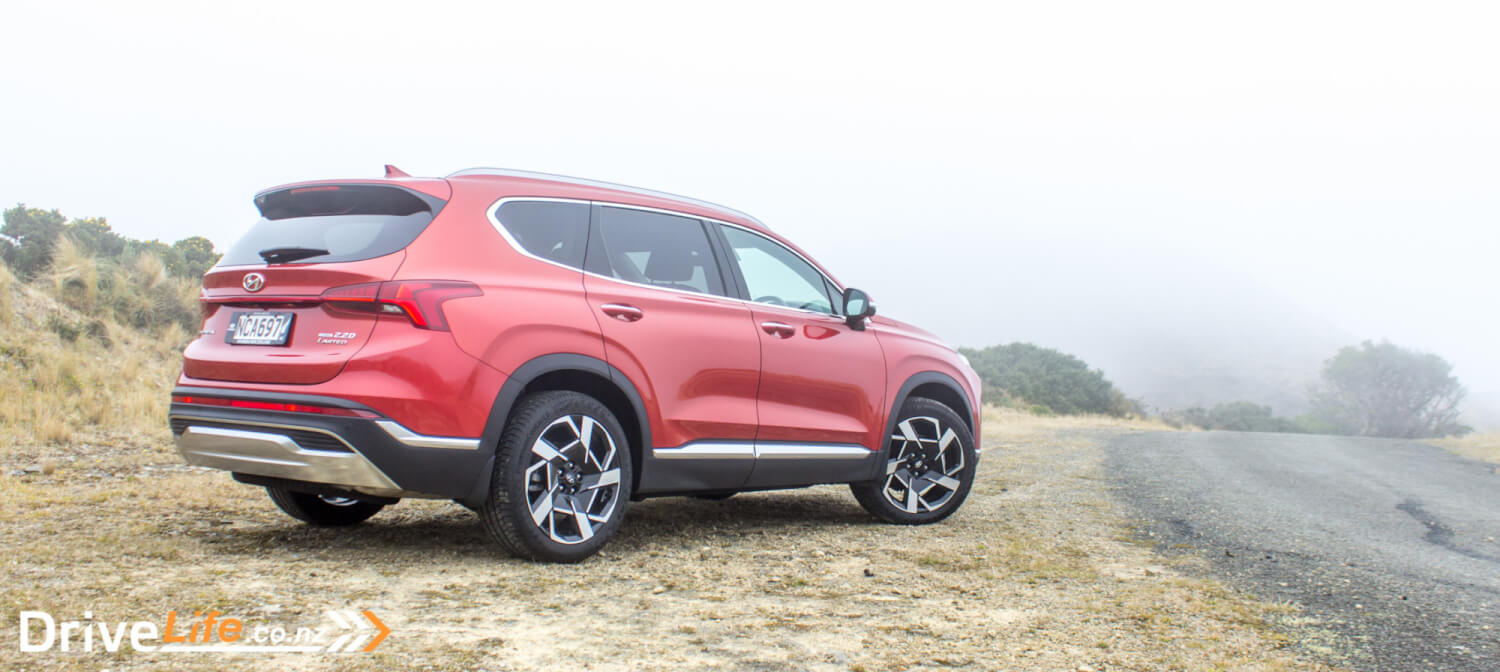
SatNav is standard of course and generally it works well, and the instructions in the HUD are clear and easy to follow. I did have issues with the SatNav a few times, where it told me to stay right on the motorway, and yet the only thing coming up was an offramp. Weird. SatNav directions are shown on the central display, the dash and HUD so you can’t really miss your turn at least. While using SatNav or just looking at the map, you have the ability to use pinch and zoom. This seems straightforward but there’s still a lot of SatNav systems out there that don’t let you pinch and zoom.
From the driver’s seat, the steering wheel controls are very Hyundai and just about perfect. They have an excellent tactile feel to them, are perfectly positioned and you rarely need to look down at what button you are pressing. This is a sign of steering wheel controls done right. Thank you, Hyundai, and please don’t change them.
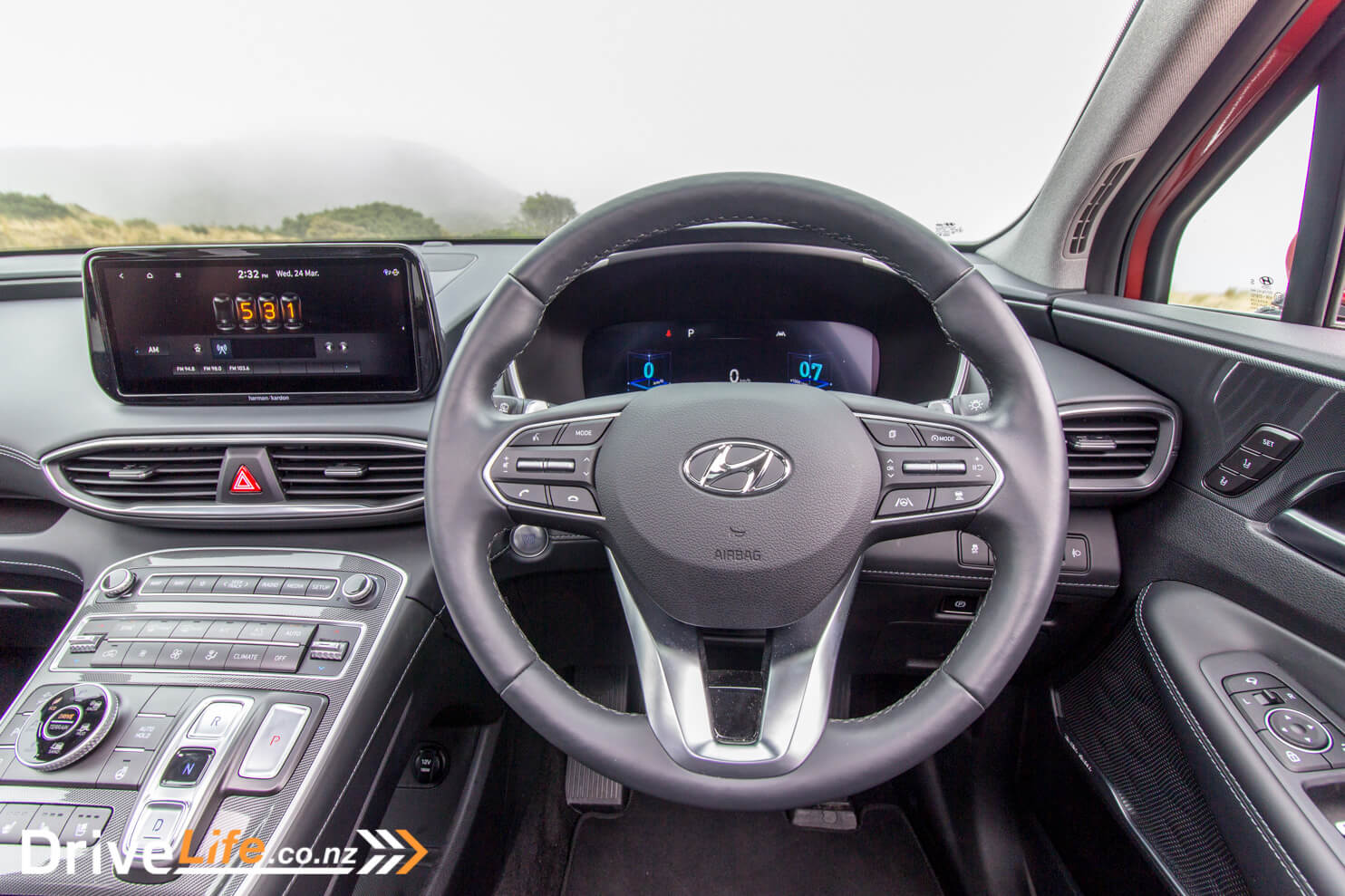
On the steering wheel is a voice command button, which nearly every car has now. A shame in the Santa Fe, it only works with Apple CarPlay or Android Auto. That means if you’re using that Qi charging slot, you aren’t going to be able to use the voice command button.
Audio quality though is excellent and there’s also a Quiet Mode, much like Tesla’s Joe Mode. Selecting Quiet Mode means that the max volume is 7, and audio only comes out of the front speakers. I can see quite a few parents of toddlers and babies loving this.
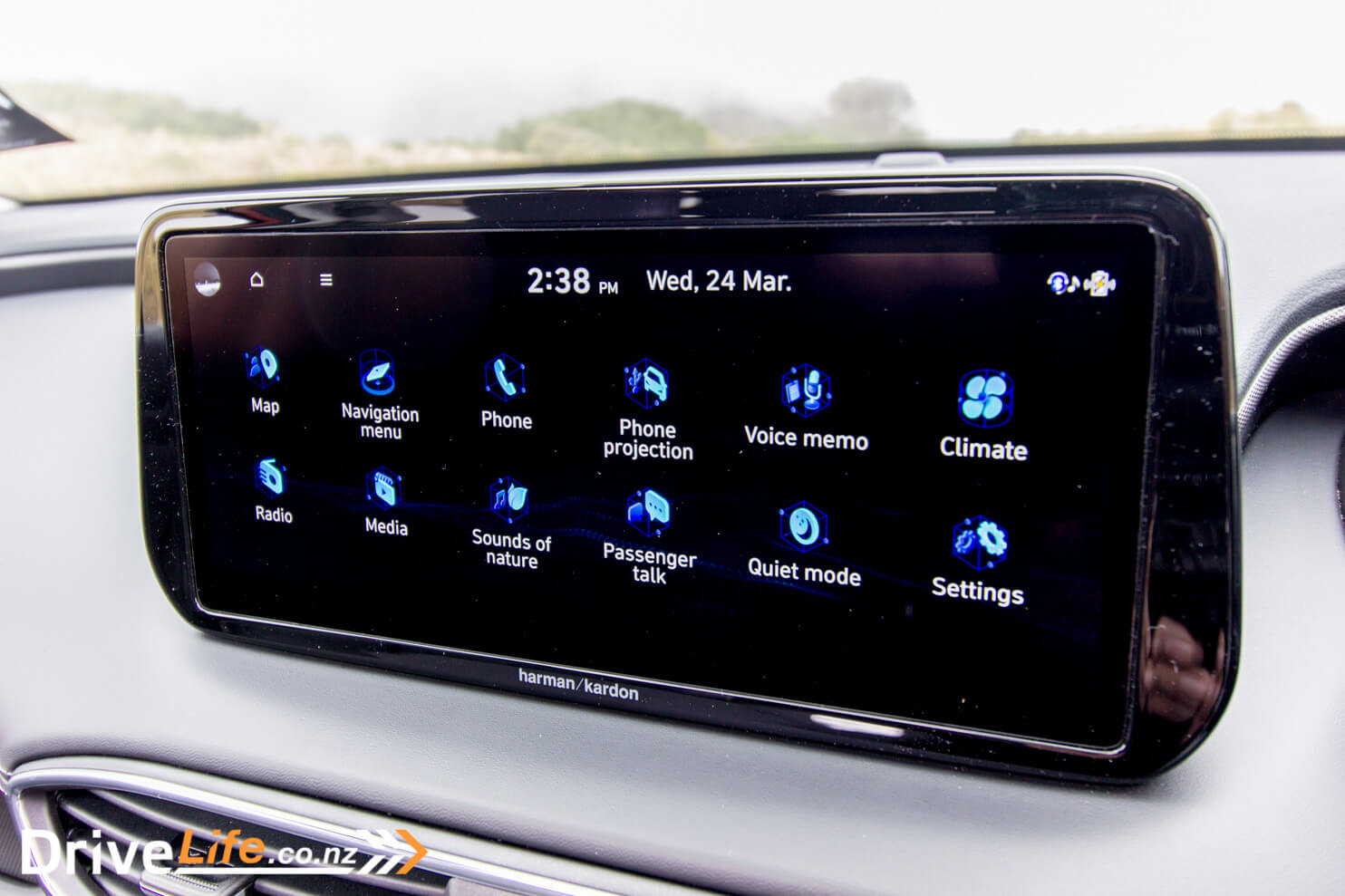
As expected, adaptive cruise control is fitted, and it’s great to see it’s a one-touch affair. So simple. It brings the car to a stop too, and this is always welcome on Wellington’s crazy motorways that have traffic lights on them. It’s a nice smooth system too, with all the controls right there on the steering wheel. Thankfully, Hyundai has not gone and moved to a cruise control stalk.
As mentioned in the specs, there’s three-zone air con in the Limited model, and this can also be tied (via the infotainment menus) to seat heating and even the steering wheel heater. This seems like overkill, but once you’ve used this system it makes a lot of sense.
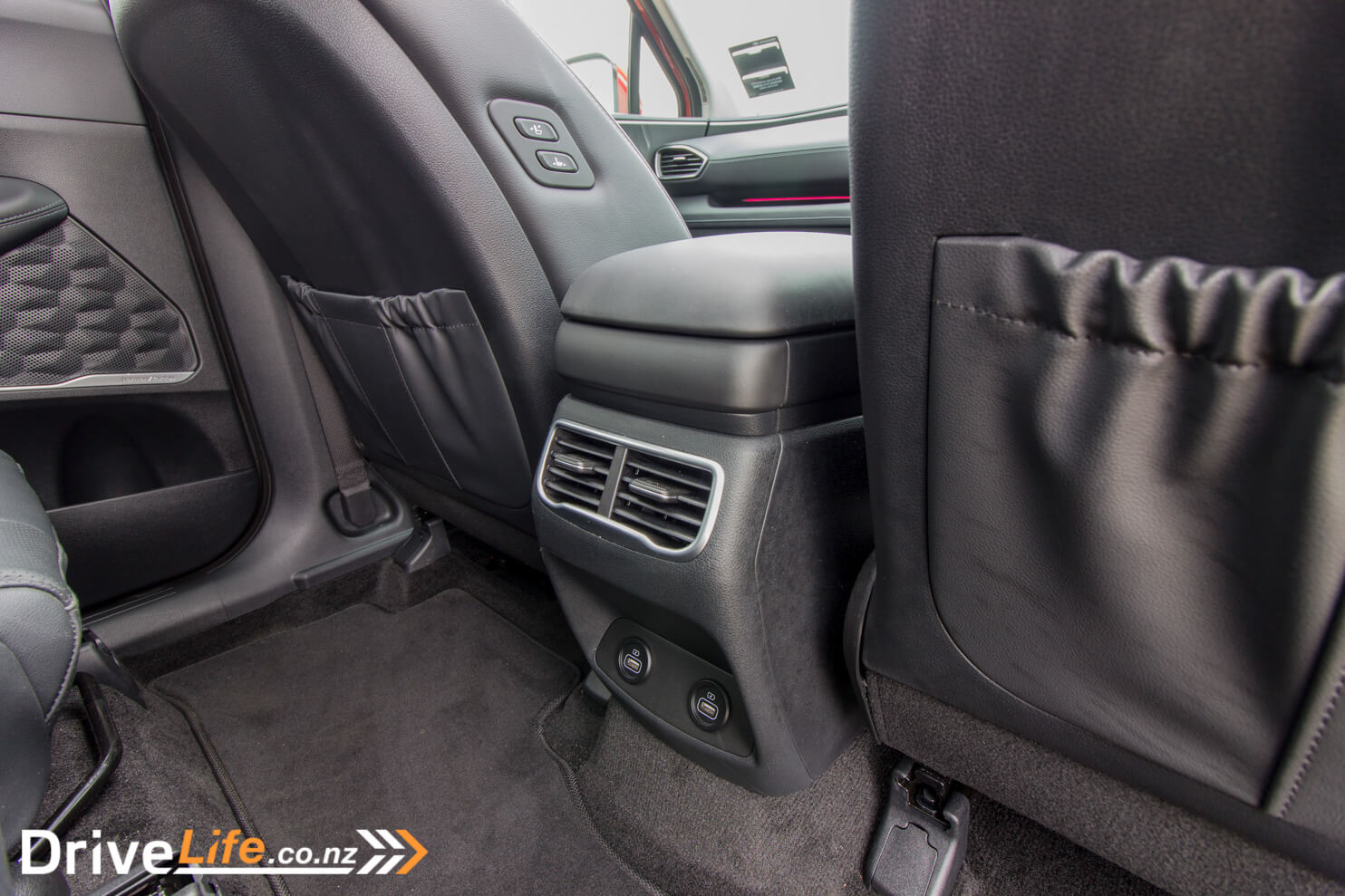
One of the excellent features of the previous model of Santa Fe was the driving dynamics. The car sat beautifully on the corners and yet rode like a dream. Chucking it around some twisty roads did not upset the car at all, and you could tell engineers had been hard at work making this car handle corners well, and yet ride well too. Is it any better or worse, in this new model? I’m happy to say, it’s exactly the same, and the grip from those Continental PremiumContact 6 tyres seems even better than before.
With a big, heavy, all-wheel drive SUV, you would think the Santa Fe would be a bit of a diesel guzzler. It’s not. After 600Km of driving, I used 7.1L/100Km in a good mix of driving conditions. Hyundai suggests a combined rating of 6.1, so I wasn’t far off that.
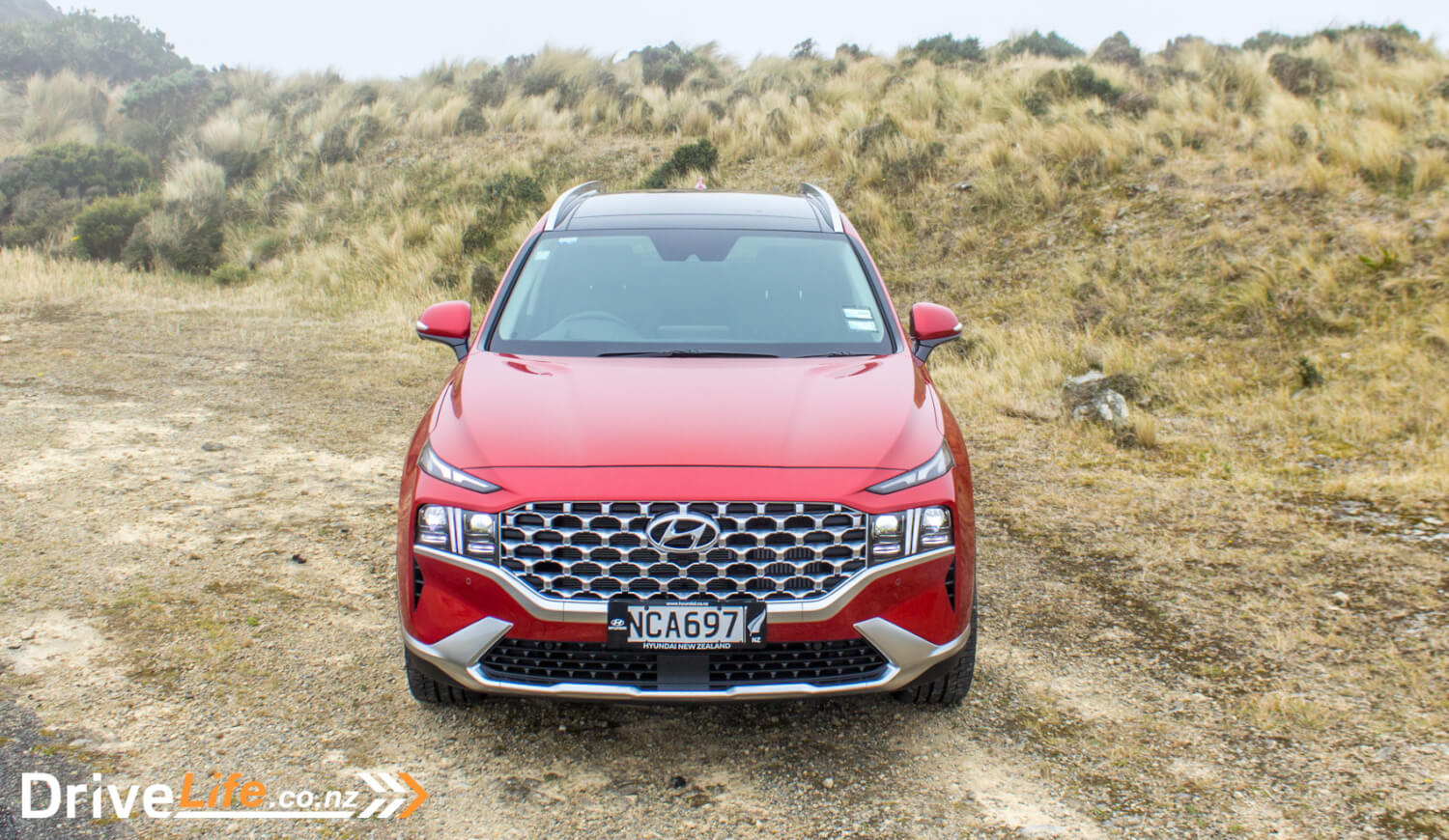
What’s The Competition For The 2021 Hyundai Santa Fe Limited?
If this table shows one thing, it’s that the Santa Fe has a lot of competition…
| Brand/Model | Engine | Power/Torque kW/Nm | Seats | Cargo capacity, litres | Towing capacity, unbraked/braked | Fuel L/100km | Price |
| Volvo XC60 T6 R-Design AWD | 2.0-litre turbo-supercharged petrol | 246/440 | 5 | 635 | 750/2,100 | 8.0 | $92,900 |
| Hyundai Santa Fe Limited AWD diesel | 2.2-litre turbo diesel | 148/440 | 7 | 571 | 750/2,500 | 6.1 | $89,990 |
| Kia Sorento Hybrid Premium AWD | 1.6-litre turbo-petrol hybrid | 132/265 | 7 | 616 | 750/1,650 | 1.6 | $89,990 |
| Ford Everest Titanium AWD | 2.0-litre twin-turbo diesel | 157/500 | 7 | 1050 | NA/3,100 | 7.0 | $79,990 |
| Skoda Kodiaq RS TDI AWD | 2.0-litre twin-turbo diesel | 176/500 | 7 | 630 | NA | 7.7 | $74,990 |
| VW Tiguan Allspace TSI R-Line AWD | 2.0-litre turbo-petrol | 162/650 | 7 | 615 | NA | 8.1 | $69,990 |
| Ssangyong Rexton SPR 2WD/4WD | 2.2-litre diesel | 148/441 | 7 | NA | 750/3,500 | 8.9 | $67,990 |
| Isuzu MU-X AWD | 3.0-litre turbo diesel | 130/430 | 7 | N/A | 750/3,000 | 7.9 | $66,690 |
| Mazda CX-8 Takami AWD | 2.2-litre turbo diesel | 140/450 | 7 | 742 | 750/2,000 | 6.0 | $66,390 |
| Seat Tarraco FR 4Drive | 2.0-litre turbo petrol | 140/320 | 7 | 700 | 750/2,250 | 7.2 | $64,990 |
| Peugeot 5008 GT FWD | 2.0-litre turbo diesel | 130/400 | 7 | 952 | 750/1,500 | 4.7 | $62,990 |
| Toyota Fortuner Limited AWD | 2.8-litre turbo diesel | 150/500 | 7 | 296 | NA | 7.6 | $59,990 |
| Mitsubishi Outlander VRX AWD | 2.3-litre turbo diesel | 122/366 | 7 | 1048 | 750/2,000 | 6.2 | $56,990 |
| Mahindra XUV5000 W10 AWD | 2.2-litre turbo diesel | 103/320 | 7 | NA | NA | 8.4 | $40,990 |
What’s The Pros and Cons For The 2021 Hyundai Santa Fe Limited?
| Pros Great engine – smooth, torquey, quiet Quality of finish Equipment Blind spot monitoring system Space Design | Cons Transmission can be jerky from stop, indecisive No traffic sign recognition Wrong speed limits shown on some roads |
2021 Hyundai Santa Fe Limited – Specifications
| Vehicle Type | 5-door, 7-seat medium/large AWD SUV |
| Starting Price | $89,990 |
| Price as Tested | $89,990 |
| Engine | 2.2-litre, 4-cylinder turbo-diesel |
| Power, Torque kW/Nm | 148/440 |
| Transmission | 8-speed dual-clutch automatic |
| Spare Wheel | Full-size alloy |
| Kerb Weight, Kg | 1,820 |
| Length x Width x Height, mm | 4785x1900x1710 |
| Cargo Capacity, litres | 571/NA |
| Fuel capacity, litres | 67 |
| Fuel Efficiency L/100Km | Advertised Spec – combined – 6.1 Real World Test – combined – 7.1 Low Usage: 0-6 / Medium Usage 6-12 / High Usage 12+ |
| Towing Capacity Kg, unbraked/braked | 750/2,000 |
| Turning circle, metres | NA Small: 6-10m / Medium 10-12m / Large 12m+ |
| Warranty | 3 Years, 100,000Km 3 years, 100,00Km Roadside Assistance 10 years/200,000Km anti-perforation corrosion warranty |
| ANCAP Safety Ratings | 5 Star |


